PinotFile: 9.7 May 9, 2012
|
Solving the Mystery of the “Coury Clone”
The mystery surrounding the origins of the so-called “Coury clone” of Pinot Noir is as enigmatic as Charles Coury himself. He has been described variously as extremely bright, stubborn, annoying, hot-tempered, lofty, and a brilliant theorist, who was never quite able to translate his innovative ideas into success in the business world. Dick Earth, who partnered with Coury in a nursery in the early 1970s in Oregon, noted in the Oregon Wine News (March 2011), “Unfortunately, he didn’t have the follow through....He just couldn’t get from A to Z.” Coury was born in Southern California but grew up in Oregon. He received a Bachelor of Arts degree in climatology from the University of California at Los Angeles in 1952 which led him to become well versed in agricultural growing seasons. While serving as a Naval officer during the Korean War, he became intrigued by French wines served in the officer’s club. After the war, this interest led him to a job selling imported European wines for Jules Wile in Southern California. He then decided to pursue a career in winemaking and entered the University of California at Davis (UCD) where his classmate was David Lett who would go on to found The Eyrie Vineyards. Coury obtained a Masters of Science degree in Horticulture from UCD, graduating June 10, 1964. He had submitted his master’s thesis in early 1964 and received his degree while in Alsace, France where he was studying cool climate viticulture.
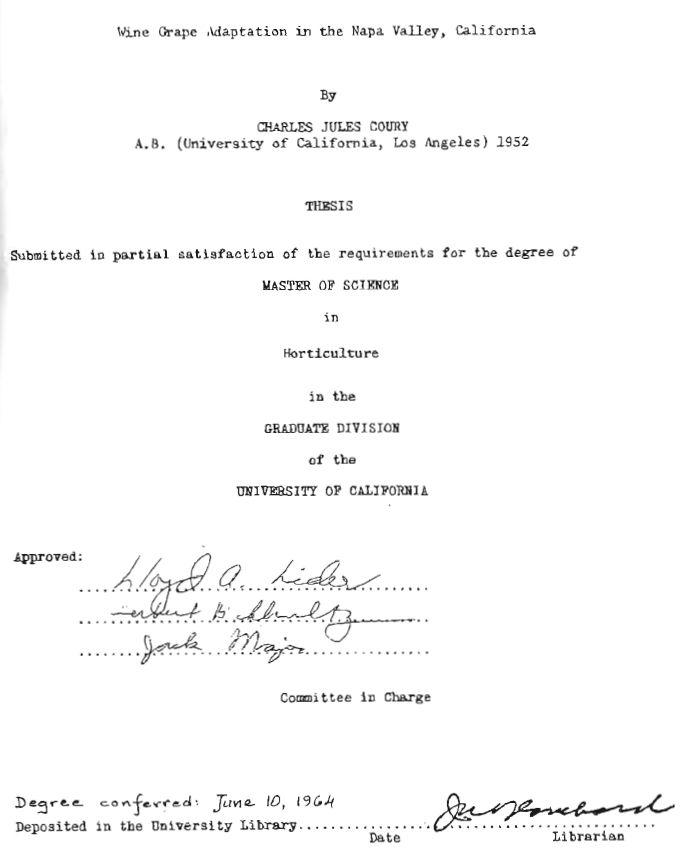 Coury’s master’s thesis was titled, “Wine Grape Adaptation in the Napa Valley, California.” Coury claimed his thesis showed him to be the first to expound the idea of pursuing winegrowing, and in particular, Pinot Noir cultivation, in the Willamette Valley of Oregon. He is quoted in The Boys Up North (Paul Pintarich, 1997) as saying, “My master’s thesis was a very, very clever approach to climate and grape choice. I knew there were great similarities between the climates of France and Oregon, which are nearly on the same latitude. My professors argued with me, but I was right. I had an absolute climatological basis for my thesis and knew that the cool, rainy conditions of Oregon would be ideal, particularly for the Pinot Noir, Chardonnay and Riesling varieties.” Coury’s pronouncements about the potential for certain varieties in Oregon turned out to be correct, but his master’s thesis did not directly reference Oregon. A review of the 112-page thesis reveals that Coury’s intent was to prove that agro-climatic analogues (environmental characteristics such as topography, soil, rainfall, day length) and the hypothesis of cold limit amelioration, combined with empirical knowledge, could lead to the successful choice of suitable varieties in the Napa Valley. There is only a single mention of Oregon (page 30) and it is perjorative: “European wine growers glory in a dry, sunny summer as in 1959 their grapes completely ripening. The same thing, in reverse, may happen in Western America. We observe as a good illustration our own 1963 California spring whose weather resembled rainy Oregon more than its own.” The truth is that Oregon summers are usually dry and sunny and 1963 was typical. Coury referenced the potential of California in his thesis by noting, “Burgundy perhaps is not the best place to grow Pinot Noir....Perhaps the best environment for these may be found elsewhere. Perhaps a region may be located where they would yield even better wines than in their home regions. Perhaps in California would be the place.” What Coury became known for was the emphasis in his thesis on the importance of selecting appropriate grape varieties for particular sites. He refuted the supposition that the heat summation classification proposed by UCD professors Maynard Amerine and Albert J. Winkler could alone adequately predict plant performance, emphasizing the contributions of topography, soil, rainfall, water balance, and day length. He drew on work by ampelographer Victor Pulliat in France in the 1800s, who had proposed a ripening classification of Vitis vinifera grape varieties in his treatise, Mille Vatieties de Vignes, Description and Synonymies (A Thousand Varieties of Vines, Descriptions and Synonyms). The just of Coury’s thesis was as follows. “Everywhere in Europe the same pattern repeats. Varieties have been selected which in the average year just barely attain adequate maturity. This consistency inspires the proposal of a theoretical approach to ideal variety adaptation: The Hypothesis of Cold Limit Amelioration. Any variety yields its highest quality wines when grown in such a region that the maturation of the variety coincides with the end of the growing season. Or another way of expressing the concept: Any variety yields its highest quality wines when grown in a region whose ecologic potential to mature fruit just equals the requirements of the variety, no more or no less.” Coury notes that the hypothesis explains the variety distribution in Europe and seems to fit the Napa Valley experience. “It is proposed as a rational approach to variety selection.” David Lett was a fellow student of Coury’s at UCD in 1964, and spent a year in northern Europe studying coolclimate viticulture. Mary Boyle (The Quarterly Review of Wines, summer 1996), quotes Lett, “After my year of studying Burgundian varieties in France, I was sure the marginal climate of the Willamette Valley was the perfect place to cultivate them in the United States.” Lett came to believe that Oregon had a growing season closest to Burgundy of any other known alternatives in the United States. Like Coury, Lett was influenced by the writings of Pulliat that emphasized the principles of ripening date classification in the choice of wine grape variety plantings. Lett hand-copied copied Pulliat’s theories in great detail in his personal notebooks. As the years went by, Coury became quite outspoken and is quoted in The Boys Up North as saying, “I was the big gun in 1965; I was a leader and talker! Not only was I a voice for the wine industry, I was a loud voice.” Unfortunately he tended to adjust time lines to suit his reputation. The truth is, a study of history and dates would indicate that David Lett should be recognized as first suggesting that Oregon possessed a suitable climate to cultivate Pinot Noir, acted on it, arrived in the Willamette Valley first, and Coury followed. My careful review of historical records would indicate the following timeline. Lett returned to the United States from Europe in the fall of 1964 and began to gather grape cuttings from UCD and other sources. Armed with several thousand cuttings, he traveled to the Willamette Valley in early February of 1965, and upon arrival, started a nursery in Corvallis where he planted several cool-climate grape varieties including Chardonnay, Pinot Gris, Pinot Meunier, Pinot Noir ( Wädenswil, UCD 2A, and Tout Droit, UCD 18), UCD 1 (Pinot franc) and Riesling. Lett’s personal journal indicates he found a suitable site to lease for his plantings in Corvallis on February 22, 1965. Willamette Valley’s first Pinot Noir vines were planted in the nursery on February 13, 1965, and planting of all varieties was completed on March 1, 1965. Lett’s first plantings in Corvallis are shown in the photo below.
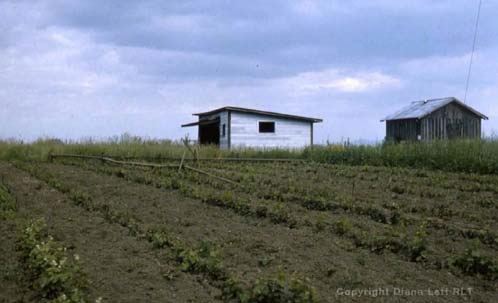 Lett’s journal indicates that on April 3, 1965, he planted some cuttings for Coury. According to Lett, the rootings had mites and were in poor condition. Coury had returned from Europe in late 1964 and first visited the Willamette Valley in the early spring of 1965 according to Lett’s journals, then returned to California, and sent his cuttings north for Lett to plant. Coury then returned to the Willamette Valley in the summer of 1965, and after researching appropriate sites and talking with old timers who had grown grapes successfully in the Willamette Valley, chose a suitable site in Forest Grove, an old cattle ranch and farmstead known as David Hill. The records from the Office of County Assessor in Washington County indicate Coury obtained title on October 5, 1965. It is unlikely Coury planted a nursery on the property before obtaining title, so it can be assumed that his Forest Grove nursery was first established some time after the close of escrow and most likely in 1966. Lett subsequently located his original vines to his ideal vineyard site in the Red Hills of Dundee. Field preparation and transplanting began in 1966 when David, and his new spouse, Diana, founded The Eyrie Vineyards. Coury planted his first vineyard in Forest Grove the same year, confirmed by the obituary of Coury’s spouse, Shirley. Lett was to receive considerable recognition for his wines and deservedly so, since his Pinot Noirs set the mark and won international recognition for the fledgling Oregon wine industry. Coury’s wines, in contrast, never achieved critical success, and unable to develop a following, Coury left the Willamette Valley in 1978.
Coury studied cool climate viticulture and clonal adaptation at INRA (National Institute for Agronomy Research) in Colmar, Alsace, France with the viticulturist Pierre Huglin in 1964, and this is where the mysterious origins of the “Coury clone” can be traced. David Adelsheim told me, “There has always been the story that Coury had smuggled cuttings into the United States, presumably from Colmar. When Coury was in Colmar, clonal selection work was focused on finding one or more clones of each variety that represented the typical attributes sought in Alsace. There was only one clone of Pinot Noir available at the time, clone 538. At a tasting of a range of Oregon Pinot Noirs in the fall of 1973, Coury amazed everyone with a very dark-colored wine made from a Pinot Noir clone whose identity and origin he would not reveal. I suspect it was clone 538. Oregon State University (OSU) received this clone in 1975, along with the clones of all the other Alsatian varieties. I do not know who ever planted it commercially.” Viticulturist Steve Price, formerly a professor at Oregon State University (OSU) and now the owner of a consulting company, Price Research Services, Inc. offering technical support for the wine industry in Oregon, California and Australia, related the following to me about Colmar 538. “When I arrived at OSU in 1983, Colmar 538 was already planted in two clonal trials first established in 1979 (as part of the Winegrower’s Project). Also in those trials were UCD 4 and 5 (Pommard) and UCD 13 (Martini). My understanding was that the Colmar clone came in with other clones direct from Espiguiette (Espiguette 236 and 374) in southern France through the plant importation permit held by OSU at the time. Espiguiette was a test station in the French viticulture program where suitable clones were identified. The Colmar 538 clone (also known as CTPS 162) was planted on a small commercial scale in Oregon. It appeared to be a typical Pinot fin type in early trials but seemed to have larger clusters and was not considered particularly desirable. It was also included in a second round of Pinot Noir clone testing at OSU planted in 1989-1990.” The program started by OSU and the Oregon wine industry in the mid 1970s known as the Winegrower’s Project was intended to introduce and evaluate a selection of virus-free Pinot Noir clonal material. Several clones were sourced from UCD and additional clones were obtained directly from France and indexed virusfree at OSU. Twelve vines of each clone were planted in 1979 (Colmar 538 in 1980) at two grower-cooperative sites in the Willamette Valley: the Knudsen-Erath Vineyard and Five Mountain Vineyard. Growth and production data were gathered from 1985 to 1987 and the results were presented at the Second International Symposium for Cool Climate Viticulture and Enology in Auckland, New Zealand in January 1988. Red wines were also produced from the clones in 1985 from the Knudsen-Erath Vineyard and in 1986 and 1987 from both of the grower-cooperator sites. Other than commercial industry standard clones UCD 2A (Wädenswil) and UCD 4 (Pommard), clones which rated high overall and had strong potential for the production of premium quality Pinot Noir were UCD 1 (Pinot franc), UCD 12 (Spain), UCD 29 (Jackson), and Colmar 538. Consistent patterns emerged among the clones regardless of site or season. A second round of clonal plantings occurred in 1989-1990 in Alpine, Oregon, and the results reported in the Proceedings of the International Symposium on Clonal Selection in 1995. Twenty Pinot Noir clones including Colmar 538 were compared, all planted in 1989 with 1994 the first year of full production. The trial included clones from INRA, ONIVINS, and ANTAV in France and FPMS in California. Colmar 538 was considered a fertile group clone (large clustered, prostrate) based on 1994 yields and cluster weights. In comparison with the other clones, it showed low wine color intensity, low total phenolic content and low titrable acidity from berry samples and finished wine. Colmar 538 came to FPS at University of California at Davis in 1987 from France from OSU Winegrower’s Project. Now deemed FPS 48, it is reported to be former INRA-CV-clone 538. Because the selection came to the United States before initiation of the official ENTAV-INRA trademark program, the clonal authenticity cannot be guaranteed. The official ENTAV-INRA clone number for the former INRA 538 is now ENTAV-INRA clone 162.
Dick Erath told me that when Coury returned to California from Alsace in late 1964, he brought in cuttings and had his father successfully root them for him in Carneros, California. This makes sense, since in Coury concluded in his master’s thesis that Carneros was the most suitable for growing Pinot Noir of all the subregions of the Napa Valley. The suitcase vines were subsequently shipped to Oregon and Coury apparently first planted them at his property in Forest Grove. Coury told Erath that the cuttings arrived in a dried out condition and he suffered loses. When Erath first saw the planting of vines from Alsace in October of 1967, they were struggling at best. He recalls that Coury made a barrel of Pinot Noir in 1970 from a secretive source (presumably the “Coury clone” as he would not identify its source), and it was a big, dark and extracted wine. Among the cuttings Coury sent from California that were planted in David Lett’s initial nursery vineyard in Corvallis both for Coury in April, 1965, and later with Coury, there is no mention in Lett’s journal that the plant material came from Alsace. As noted, Coury had found a suitable location for his own nursery vineyard in Forest Grove in 1965, but did not plant his first vineyard there until 1966. There is no evidence to indicate that Coury planted any “Coury clone” vines in Forest Grove before 1966, so although Erath is not certain when the suitcase vines were first planted in Forest Grove, it is reasonable to assume it was 1966. According to Jason Lett, his father, David, provided Coury with significant amounts of cuttings from his stock of clones UCD 1 and UCD 18 which were presumably planted at Forest Grove as well. Dick Erath was an early importer of Pinot Noir plant material into Oregon. He had enrolled in a course at UCD in 1967 and met Richard Sommer, who encouraged him to go to the Willamette Valley. One of Dick’s professors, Dr. Vernon Singleton, told him that Charles Coury and David Lett had gone to the Willamette Valley to plant vineyards and make wine. Erath met Coury in 1967 at his vineyard in Forest Grove while interviewing for a job in Oregon. Erath began to gather plant material for his own plantings in Oregon as early as 1967. He obtained Wädenswil (UCD 2A) from a Wente increase block planting in Arroyo Seco that had originated at the FPMS mother vineyard block at Davis, as well as cuttings from over twenty other varieties obtained through UCD including Pommard. He even introduced the Jackson clone of Pinot Noir, UCD 29, to Oregon which never achieved popularity. He planted his first vineyard, which included Pinot Noir, in the Chehalem Mountains in 1969 and released his first Pinot Noir under the Erath label in 1972. Dick Erath and Charles Coury were partners in the Erath-Coury Nursery from 1970 to mid-1971. They obtained a range of registered vines grown from cuttings as well as mother vines from California. Some were from the Oki Nursery close to the University of California at Davis and included clones released from the UCD Foundation Plant Material Service (FPMS) heat treatment program run by Austin Goheen at the time. Goheen was a brilliant researcher working for the USDA at UCD where he put the heat treatment and virus indexing of grapevines in place after going through the entire mother block of vines at UCD. Erath recalls that when he visited the increase block of plantings at the Oki Nursery with Goheen, both heat-treated and less vigorous non-heat-treated clones of Pinot Noir were planted side by side and an employee, Clemente, stated they were not kept separate. Among the clones brought into Oregon by Erath and Coury was Pommard. The oldest sources of the Pommard clone are two that were introduced into California by Professor Harold Olmo at University of California at Davis in 1951. One of the cuttings came from the walled vineyard at Château de Pommard and was designated Pommard 04 (UCD 4). Pommard 04 is the only selection in the FPMS program documented as originating directly from a producing European vineyard. Pommard 04 was registered in the FPMS program from 1963 to 1980, widely planted in California, but then removed because it tested positive for Pupestris Stem Pitting (RSP+). Pommard 05 (UCD 5) and 06 (UCD 6) (grouped together under the designation FPMS 103) were created from Pommard 04 using thermotherapy in 1964 and technically are one clone. They were both registered from 1967 until 1980 when they were also removed because they also tested RSP+. Recently, selection FPMS 91 was created from Pommard 04 using microshoot-tip culture. It became registered as the new Pommard selection in 2002 and UCD 4, 5 and 6 are no longer registered.
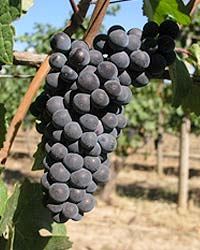 Pommard was introduced to Oregon through the FPMS program via multiple sources including the Oki Nursery in Davis. Erath brought Pommard (FMPS 103: row D4, vine 1) to the Willamette Valley in 1970. According to noted Pinot Noir historian and writer, John Haeger, there is confusion about whether the Pommard clone sold into Oregon was UCD 4 or its heat-treated cousin, UCD 5, or both, but Erath is certain that he brought in FMPS 103 (specifically F7V13: row F7, vine V13 of UCD 5). At the time, Erath, Coury and Lett were adamant about only importing certified root stock into Oregon. Although the Oki Nursery did not appear to make a distinction between non-heat-treated and heat-treated Pommard, according to Erath when he visited the nursery with Goheen, it is unlikely a certified nursery would misrepresent non-heat-treated plant material. While partnered with Coury, Erath also introduced into Oregon, PN 3A (specifically G6V1, V2: row G6, vines V1, V2), one of three Pinot Noir clones sent to UCD by Werner Koblet from the research station in Wädenswil, Switzerland sometime before 1962. According to Adelsheim, it may be the same clone that is planted at Bethel Heights Vineyard, much later ripening than the clone planted by David Lett that he got from Wente in 1965, which is thought to be UCD 1A. Erath also brought in FPMS 104 (G8V3: specifically row G8, vine V3), the designation for the Martini clone of Pinot Noir at the time. There were a number of factors that led to a relatively short partnership between Erath and Coury, but Erath told me the following. The partners had established their nursery in a greenhouse space in Portland. The quarantine against phylloxera required that imported vines initially had to be grown in a greenhouse. In 1970 and 1971 there was a frost in the winter with temperatures in the mid-20’s. The vines were in gallon cans above ground and fully exposed and many suffered root damage. This was unfortunate timing, since a demand was developing by upstart winegrowers in Oregon for the Pommard clone. Because of the loss of stock, the Erath-Coury Nursery could not fill their many orders for May 1971 delivery. Erath wanted to send a letter out to those who had ordered vines explaining that the mother vines were slow to recover and could not be delivered in time for planting in 1971. Coury declined to do that, and the partnership was disbanded.
After the dissolution of the Erath-Coury Nursery partnership, Coury sold vines to growers in Oregon drawing upon the Pinot Noir vines from his venture with Erath and the suitcase cuttings he had brought from Alsace. He also bought large quantities of plant material from the Oki Nursery in Davis. This is where the mystery intensifies. According to Erath, the Erath-Coury Nursery never sold any of the vines that originated from Coury’s Alsatian suitcase cuttings. Coury did sell them later along with any number of clones including UCD 5 Pommard, UCD 13 (Martini clone), and clones UCD 1 and UCD 18 (from David Lett). Coury sold an assortment of clones under the guise of certified “Pommard clones.” This is corroborated by the following stories from Oregon growers. David Adelsheim bought “Pommard clone” vines twice from Coury to plant in 1974. The first shipment was vines Coury had rooted over winter in the greenhouses at his vineyard. At some point, Adelsheim had reason to question whether they were really Pommard clone and so Adelsheim called the person, whose name was Clemente, at Oki Nursery in California, from whom Coury had obtained the cuttings. Clemente had a mother block of certified vines from the Foundation Plant Materials Service. When Adelsheim asked Clemente which clone of Pinot Noir was sold to Coury, he had no idea. He just knew that it was Pinot Noir. As I noted earlier, Erath told me that Clemente had both heat-treated and non-heat treated Pinot Noir growing side by side (which Austin Goheen showed him) and did not think that Clemente kept them separate. In 1974, there were only two heat-treated clones of Pinot Noir available from the FPMS: UCD 5 (Pommard) and UCD 13 (Martini). Adelsheim believes that what he received from Coury in the first shipment was either entirely UCD 13 or a mix of UCD 13 and UCD 5. The wines made from that block are distinctly different from anything else produced at Adelsheim Vineyard and are bottled most years as a single-vineyard Pinot Noir called Quarter Mile Lane Vineyard. Cuttings from Coury’s first shipment are also planted at Adelsheim’s Boulder Bluff Vineyard. Adelsheim’s second shipment was definitely UCD 5. He has taken cuttings from that planting and used them in many other vineyards and even sold them to friends in California when that clone was in limited supply there. Wines made from that block and its children definitely taste like Pommard. Adelsheim points out that Coury sold vines to several others including Bill Wayne of Abbey Ridge and John Bauer of Goldschmidt Vineyard (now named Winderlea Vineyard and owned by Bill and Donna Sweat) about the same time as Adelsheim obtained his vines. He says, “To assume that everyone who purchased vines that year got the same thing, and that it should be called the “Coury clone,” cannot be supported. We alone got two different things from him that year. Who knows what others got. We refer to the vines planted from that first delivery in 1974 as Selection QM1, since it’s what’s planted in block one at our Quarter Mile Lane Vineyard. I have no idea if it’s at all related to what the Waynes or the Bauers received.” Bill Wayne, the owner of Abbey Ridge Vineyard in the Dundee Hills also bought vines from Coury. Wayne and his wife Julia first planted Abbey Ridge Vineyard in 1977-1978 and is one of Oregon’s oldest producing vineyards. Wayne told me he bought some “Pommard” from Erath in 1978, and after a few years, he noticed there were some rogue vines mixed in including Gewürztraminer and some unusual, late ripening red variety. When he needed more Pommard vines to expand his vineyard in 1982, he obtained cuttings from Hyland Vineyard, because they were reputable growers and he assumed they did not have rogue vines. Wayne rooted the cuttings and all seemed normal until about five years later when he noticed that the fruit from the 1982 “Pommard” plantings was not at all like the fruit from the “Pommard” block planted from Erath’s cuttings. The 1982 plantings had clusters that were smaller, ripened earlier, the leaves were different, and the canes were smaller. When he asked Jack Trenhaile, who had planted Hyland Vineyard along with the Kreimeyers, Markleys and Welches in 1971 and had managed it until 2007, where he obtained the budwood for the cuttings Wayne had bought, he said they had come from Coury’s vineyard near Forest Grove. Hyland Vineyard initially was planted exclusively to Coury “Pommard. Some time later, Wayne asked Mark Teppola, who was farming the old Coury vineyard, about some “Pommard” that was atypical in his own vineyard. Teppola knew what he was talking about, but had no idea of the origin of the budwood. Wayne also spoke to a friend who grew up with Coury’s son, but by then Coury had left the grape business and was living in California. Finally, at a Christmas party, Wayne’s friend asked Coury where he got the budwood for the atypical “Pommard” with the small clusters, and he confessed that he had “suitcased” the original budwood from a vineyard in Alsace and it was never Pommard. Wayne never did find out more about the origin, but, along with others, began calling it the “Coury clone,” or “Coury Pommard.” Joel Myers is a veteran Willamette Valley viticulturist whose vineyard management company, Vinetenders, has managed Hyland Vineyard since 2009. The Myers family lived across the street from Charles and Shirley Coury and their two boys in Sacramento while Coury was studying at the University of California at Davis, finishing his master’s thesis. Coury later confided in Myers that he brought suitcase cuttings into the United States from Alsace and planted them in Carneros where they did well. Coury said the clone was a wellperforming Pinot Noir clone in Alsace, but “was not identifiable as an Alsatian clone.” He did not want to get into trouble so he did not disclose the source of the vines to anyone. Myers said the morphology of the “Coury clone” planted at Hyland Vineyard is distinctly distinguishable from true Pommard, having smaller clusters and slightly less leaf veins. Myers does not believe the “Coury clone” is the same as Alsatian clone 538. In 2007, certified Pommard, Wädenswil, and Dijon clones were added to the mix at Hyland Vineyard, but the over 100-acre vineyard remains predominantly “Coury clone.” Winemaker Laurent Montalieu, one of the current owners of Hyland Vineyard, understood that the plant material from the Erath-Coury Nursery intended for Hyland Vineyard did not survive a severe frost. He believes Coury instead sold four families that planted Hyland Vineyard his Alsatian stock and it was rooted in 1971. Erath told me that Hyland Vineyard did plant some Pommard (FPMS 103) from mist propagated vines he supplied in 1971, but were planted late in the season because of the freeze damage to the mother vines. The timing of the breakup of the Erath-Coury partnership in mid-1971 coincided with the Hyland Vineyard initial planting, apparently confirming Erath’s claim that the Alsatian stock was not sold during their partnership. Coury sold vines to the Wahle family who began planting the original Wahle Vineyard in 1974, the first commercial vineyard planted in the Yamhill-Carlton District of the Willamette Valley. Mark Wahle, MD, the current owner and winemaker of Wahle Vineyards and Cellars, recalls traveling with his family to Coury’s nursery in Forest Grove in the early and mid-1970s. Mark’s father passed away in 2011 and eventually Mark hopes to sort through his father’s records on those vine purchases. The vines were originally self-rooted and have been a prized one for the winery. Mark is now planting some grafted “Coury clone” from Duarte Nursery at a newer vineyard site (Holmes Hill) in the Eola Hills. “Coury clone” vines are also at Abre Vert Vineyard (Chehalem Mountains), Battle Creek Vineyard (135 acres of Pinot Noir on the southeastern side of Salem, first harvested in 2002), Beran Vineyards (planted in 1972 and 1979, Chehalem Mountains), Coeur de Terre Vineyard (initially planted in 1998, McMinnville), Emery Vineyard (WillaKenzie Estate), Hawk’s View Vineyard (Hawks View Cellars, planted in 1991, 1997 and 1998, Chehalem Mountains), Laurel Vineyard (11 acres planted in 1981 in Chehalem Mountains), Noble Knob Vineyard, Olson Estate Vineyard (Torii Mor, Dundee Hills, originally planted in 1972), Alexana Vineyard (planted in 2003, 2006 and 2007, Dundee Hills) and Trisateum Ribbon Ridge Estate Vineyard (planted in 2007, Ribbon Ridge). Undoubtedly, there are a number of other vineyards in Oregon to add to this list, especially those that were planted in the 1970s by Ponzi and others.
It is impossible to specifically characterize the “Coury clone” since Coury sold various selections from his original plants including true Pommard clone and morphological signs such as cluster and berry size can be radically influenced by site. This was demonstrated when I asked several winemakers and growers about the appearance of “Coury clone” fruit. Most said the clusters were smaller than Pommard, but Lynn Penner-Ash, who has worked with vineyards that contained the “Coury clone” since moving to Oregon in 1988, told me she thought the clusters were larger with larger grapes. She confided, “I always thought the Coury plantings were a mixture of Pommard and Wädenswil to be honest!” Winegrower and winemaker Laurent Montalieu also told me that he thought the “Coury clone” was mid way between Pommard and Wädenswil. Vine Morphology: usually smaller clusters; both large and small grape size reported, but more often small; less leaf veins. Sensory Character of Wines made from “Coury clone”: good to great color; rich, fruity and intense wines; Penner-Ash describes the wines as lighter, spicier, fresh red fruit character with a wonderful texture. Amy Wesselman characterizes the wines from Abbey Ridge Vineyard from which she has made “Coury clone” Pinot Noir for 20 years as possessing a very distinctive hallmark that is hard to pin down, showing everything from lavender to savory herb to meaty to olive oil. She notes that it is always her most age worthy Pinot Noir, even though it has more finesse and elegance than anything else she bottles. Jason Lett describes a “funky, animal flavor.”
1) Charles Coury brought suitcase cuttings of Pinot Noir from Alsace into the United States in 1964, planted them in Carneros, and transplanted them to Forest Grove, Oregon. He never disclosed the clonal or selection type and this has never been determined. 2) Various selections from Coury’s original plantings have been replanted in Oregon and called “Coury clone” but there is no line from a single plant source other than material that traces back to its origins at FPMS. It is thus incorrect to refer to a “Coury clone,” as it is not a true clone. 3) The term “Coury clone” has become common parlance among wineries, winemakers and winegrowers to refer to the vines Coury sold from his nursery in the 1970s to growers and wineries in Oregon. 4) Pommard was brought into Oregon through the FPMS program via multiple sources but it is not a “Coury clone” other than it may have been included in some of his early material.
The Alsatian suitcase material known as the “Coury clone” has never been submitted to FPMS for inclusion in their catalog. I contacted Neil Shay, Director of the Oregon Wine Research Institute at Oregon State University and Professor of Food Science & Technology and asked for his assistance. He is planning to obtain plant material from vines identified as the “Coury clone,” and send them for DNA sequencing to identify a possible clonal source. Several vineyards will be sampled. Joel Myers told me that the “Coury clone” vines are not virused. It is not known if they were heat-treated, but since they exhibit moderate vigor, it would be unlikely if they were not. If the plant material turns out to be unique, it could be sent to FPMS at UCD and considered for inclusion in their catalog. Stay tuned.
Domaine Drouhin Oregon: New World’s Burgundy PresenceBurgundy’s first venture into the New World was destined in 1961 when Robert Drouhin, the daring Chairperson of Maison Joseph Drouhin from 1957 to 2003, visited California. He met with Robert Mondavi who suggested investing in California, but Robert Drouhin’s interest was in Pinot Noir, a variety that had not yet achieved success in California, and he realized he would have to look elsewhere. In 1979, Robert Drouhin set up a blind tasting of French Burgundies versus their American Pinot Noir counterparts. At this now famous Gault-Mileu tasting held in Paris, a 1959 Domaine Drouhin Chambolle- Musigny came in first, but David Lett’s 1975 The Eyrie Vineyards South Block Reserve Pinot Noir took second. This impressed Robert enough that he looked to Oregon for overseas investment. In 1987, struck by the resemblance of the Williamette Valley to the Côte d’Or, and impressed by the wines produced by Oregon’s pioneering Pinot Noir winemakers, Robert initiated the purchase by Maison Joseph Drouhin of 100 acres in the Dundee Hills overlooking the town of Dundee. Robert chose his daughter, Veronique, part of the fourth generation of the Drouhin family and a 1985 graduate of the University of Dijon, to direct the new project in Oregon, known as Domaine Drouhin Oregon. Veronique oversaw the initial planting of vineyards at Domaine Drouhin Oregon in 1988, and crafted the first three vintages, 1988 to 1990, from purchased grapes. The early wines were well received by the wine press. More land was purchased and today there are 225 estate acres, 90 of which are densely planted to Pinot Noir and Chardonnay. In 1989, a four-level gravity-fed winery was constructed, the first of its kind in Oregon. Maison Joseph Drouhin had become the first Burgundy house to make wine outside of France and today remains the most significant Burgundy presence in the New World. Through the years, Veronique-Boss Drouhin (her husband, Michel Boss, is a website designer and together they have three children) has been a long distance winemaker, continuing to live in Beaune, but traveling to Oregon every six weeks or so to oversee the winemaking at Domaine Drouhin Oregon. She also oversees the winemaking style in Beaune. The Pinot Noirs of Domaine Drouhin Oregon emphasize balance and elegance over extraction and power, and although they can be quite charming upon release, they age magnificently. Veronique likes to say the wines are “Burgundian at heart, but with North West intensity.” The wines have more extraction and fruitiness than those from Maison Joseph Drouhin, but less extraction than a number of other Oregon Pinot Noirs. Three Pinot Noirs are produced at Domaine Drouhin Oregon: Willamette Valley Cuvée, Cuvée Laurène, named after Veronique’s first daughter, and Cuvée Louise, named after Veronique’s youngest daughter. I find a similar resemblance in these three wines to their Burgundy counterparts: Willamette Valley = Village level, Cuvée Laurène = Premier Cru level, and Cuvée Louise = Grand Cru level. This is not strictly the case, and I recently asked Veronique to characterize these three different Pinot Noirs and to explain her stylistic goals for each wine. Q: Maison Joseph Drouhin has a “style,” and you have been referred to as the “guardian of that style” in Burgundy. What is your stylistic goal at Domaine Drouhin Oregon? A: I grew up tasting and drinking elegant wines, many of them, from Bourgogne appellation to Grand Crus. This is what I have heard since I was a little girl: “Pinot Noir is not a dark colored grape variety. It doesn’t naturally give a lot of tannins and when you try to extract too much, it will always be at the expense of finesse.” When we harvested our first Pinot Noir grapes in Oregon, my father opened a bottle of Domaine Drouhin Chambolle Musigny Premier Cru Les Baudes to celebrate this special moment, and said, “This is our benchmark, this is what we should aim for.” The Chambolle Baudes was extremely delicate and elegant with a beautiful long, silky finish. My stylistic goal in Oregon is to produce very elegant wines. It is more of a challenge in Oregon than in Burgundy. In both regions, the goal is the same but the challenges are different. In Oregon it is pretty easy to produce wine with both good color and structure, but to capture the finesse is more tricky. In Burgundy, it is easy to a natural elegance, but sometimes more challenging to obtain enough color and structure. Q: The winery’s tech notes indicate that Domaine Drouhin Oregon Pinot Noirs are 100% de-stemmed, naturally fermented, and raised in no more than 20% new French oak. Cuvée Laurène and Cuvée Louise receive extra time in barrel and bottle. Can you comment? A: Yes, the grapes are all de-stemmed. Sometimes in a warmer year I make a cuvée with a small percentage of stems, but in general everything is de-stemmed. The stems tend to give a strong green character to the wine more than the spicy nuances we get with stems in Burgundy. New oak is usually 20%, but with the Cuvée Laurène and Cuvée Louise, it can be up to 25% but never more. Cuvée Laurène and Cuvée Louise stay an extra two months or so in barrel. Q: What exactly are your goals with Cuvée Laurène and Cuvée Louise? These are both barrel selections, but how is that selection process different for the two cuvées, and how are they assembled to produce different wines? Are there special blocks in the vineyard involved in the selection process? Are there clonal differences? A: For Cuvée Laurène, I look for a wine with good volume, good length, more structure than the Willamette Valley Cuvée, and above all, much aging potential. The goal for Cuvée Louise would be like looking to produce my “Musigny,” the ultimate level of elegance. So the wine may or may not be as structured as Cuvée Laurène, but I look for the best balance, length and finesse. Blocks in the vineyard are an interesting point. It used to be barrel selection only for both wines, but now we see that consistently a couple of vineyard blocks make it to one or the other blend so we start to see our “terroir” show definition. We have a wide variety of clones on the estate, and have found that some do better than others, but the soil and the age of the vines are starting to be the dominant elements in the quality of the grapes. Q: For the three Domaine Drouhin Oregon cuvées, what would be your recommended drinking windows and how long would the consumer expect to comfortably age them? Also, reference this question as to the 2002, 2004 and 2005 vintages and answer the question for magnum format. A: Willamette Valley Cuvée: Average time to drink is from release to 8-10 years. 2002 was a great year that produced elegant wines with good aging potential. The wines are still delicious today. 2004 was a later and cooler vintage. The wines have a delicate structure. Drink now to another 5 to 6 years. 2005 was a big year. The wines have very good balance and excellent aging potential. Can be drunk now to another 10 years or more. Cuvée Laurène and Cuvée Louise: Average time to drink is 5 to 25 years. 2002 now to 2022. 2004 now to 2020. 2005 now to 2030. Wine in magnum will age more slowly, so another 5 years can be added to the potential bottle age. As an anecdote, we opened 6 months ago a bottle of the 1988 Pinot Noir, the first Domaine Drouhin Wine. The wine was in excellent shape. It had aged in a graceful, elegant way showing leather, tobacco aromas and still had a good mouth feel. More recently we opened a bottle of 1992 Cuvée Laurène (the first vintage of Cuvée Laurène and the year Laurène, my eldest daughter was born). The wine was simple stunning. Since 1992 was a very warm and early vintage, we did not expect the wine to age so well. Q: What is the approximate annual case production of the three cuvées?
A: Willamette Valley Cuvée: 10,000 to 12,000 cases
Q: Finally, have you learned anything from your experience in Oregon that has impacted your winemaking in Burgundy? A: Yes, the use of racks. I brought this idea back to Burgundy where we still stack the barrels one by one which is a very slow process. We still do it for almost all our wines except our Bourgogne rouge that we can now age in barrels using the space of the winery 10 months of the year. This had a big impact on the quality of our Bourgogne rouge by giving some oak aging to a good proportion of the blend. I have enjoyed many fine bottles of Domaine Drouhin Pinot Noir, but had never tasted the three cuvées side by side on the same occasion. I decided to raid my cellar and taste a mini-vertical of the three cuvées from the 2002, 2004 and 2005 vintages. The 2004 and 2005 Willamette Valley cuvées were holding nicely, with the 2002 vintage showing the most secondary characters and just past its apogee. The Willamette Valley cuvées are the most forward wines and are intended to be ready for drinking upon release. The Laurène cuvée is the most structured and has the most obvious acidity. The Louise cuvée is a wine apart with submerged acidity, the most refinement and a pleasingly velvet mouth feel. Both Laurène and Louise cuvées are still very young and I would recommend decanting if you plan to drink them now. I was surprised by the intensity of fruit in the Lauréne and Louise cuvées in the vintages sampled. I agree with Veronique comment that the 2005 vintage wines, which showed the most tannin, are big and dark fruited without being overripe, and have the longest aging potential of the three vintages sampled.
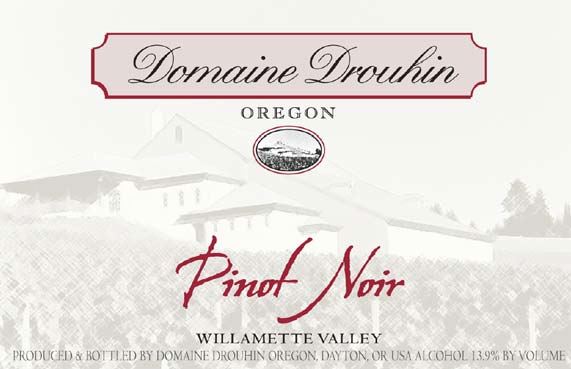
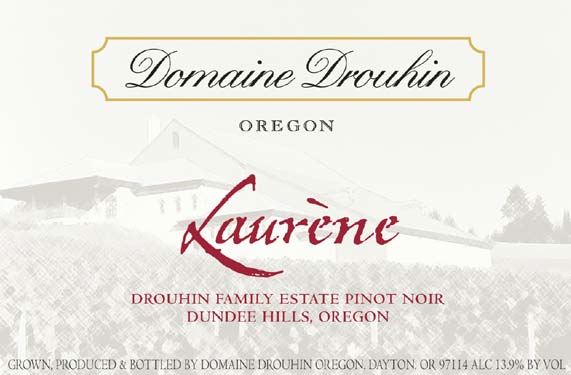

2002 Domaine Drouhin Oregon Willamette Valley Pinot Noir 14.1% alc. · Medium reddish-purple color in the glass. Aromas of leather wallet, tea leaf, cigar box and a hint of toast. Lively flavors of spiced black cherries and red berries with a hint of leaf and earth in the background. Medium weighted and light on the palate. The wine is remarkably fresh upon opening for a ten-year-old wine, but over time in the glass it fades some with tannins surfacing that supersede the fruit. Tasted the following day from a previously opened and re-corked bottle, the wine had faded further and the fruit tasted pruney. Drink up. Good (+).
2002 Domaine Drouhin Oregon Laurène Drouhin Family Estate Dundee Hills Oregon Pinot Noir 14.1% alc.. · Moderately dark reddish-purple color in the glass. Initially the nose is muted, but responding nicely to swirling, developing an attractive perfume of fresh black cherries. Moderately rich and attractive flavors of dark red berries, black cherries and black plums with subtle oak unveil themselves slowly in the glass. Ripe, firm tannins, admirable balance, and impressive length on the finish. This wine has several years of fine drinking ahead. Decant if you drink now. Very good (+).
2002 Domaine Drouhin Oregon Louise Drouhin Family Estate Dundee Hills Oregon Pinot Noir 14.1% alc.. · Moderately dark reddish-purple color in the glass. Complex and beguiling with aromas that dance in and out of the glass including black cherries, fennel, balsam and Herbs de Provence. Soft and smooth on the palate with discreetly concentrated flavors of dark red cherries and berries, tea and fresh herbs. The tannins are refined and supple, and the sensuous mouth feel is a real delight. The finish is extraordinary long with fruit flavors lingering for what seems like a minute. Still beautiful the following day from a previously opened and re-corked bottle. An exceptional, suave wine that that really grabs your attention.
2004 Domaine Drouhin Oregon Willamette Valley Pinot Noir 14.1% alc.. · Medium reddish-purple color in the glass. Ripe fruit aromas of dark currants, dark red cherry, raisin, tea leaf, spice and exotic wood. Moderately rich and tasty featuring ripe fruit flavors of black raspberries and cherries with a hint of sassafras and chicory. Soft tannins, bright acidity, polished texture and a lively finish. A few more years of life ahead. Good (+).
2004 Domaine Drouhin Oregon Laurène Drouhin Family Estate Dundee Hills Oregon Pinot Noir 14.1% alc.. · Medium reddish-purple color in the glass. Initially the nose offers scents of leather, toast and soy, evolving slowly to reveal engaging dark red fruit aromas. Mid weight flavors of dark red and blue fruits, especially dark raspberry, with a slight herbal and soy tone. Well structured with impressive fruit-filled length on the finish. Very good (+).
2004 Domaine Drouhin Oregon Louise Drouhin Family Estate Dundee Hills Oregon Pinot Noir 14.1% alc.. · The aromas really draw you in, offering an engaging perfume of perfectly ripe black cherries, savory herbs and subtle oak. There are not enough superlatives to adequately describe this wine. A few that come to mind are luscious, seamless, velvety, and incredible. Enticing upon opening, the wine becomes silkier and livelier with air. The wine displays remarkable fruit intensity, but is very light on its feet and impeccably balanced. Many years of pleasure ahead. Veronique talks about great wines producing emotion, and this wine elicited a multitude of them for me.
2005 Domaine Drouhin Oregon Willamette Valley Pinot Noir 13.9% alc.. · Moderately dark reddish-purple color in the glass. Still primary aromatic character offering scents of fresh black cherries and dark red berries, with a hint of forest floor and oak. Rich dark red berry core with a subtle smoky, tarry note. Fresh and juicy, polished and silky, with a firm tannic backbone. Doesn’t have the finish of the prestige cuvèes, but a solid wine that is reflective of a big, hearty vintage. Very good.
2005 Domaine Drouhin Oregon Laurène Drouhin Family Estate Dundee Hills Oregon Pinot Noir 13.9% alc.. · Dark reddish-purple color in the glass. Subdued aromas of berries, ripe grapes, cassis, shitake mushroom, oak, and cherries sprinkled with flowers. Richly endowed with a core of ripe dark cherry and black raspberry fruit. A bit linear and unevolved, becoming more expressive over time in the glass. The fruit is still buried in tannin and the wine is rather monolithic now, but the potential is obvious. Be patient on this one. Very good.
2005 Domaine Drouhin Oregon Louise Drouhin Family Estate Dundee Hills Oregon Pinot Noir 13.9% alc.. · Dark reddish-purple color in the glass. Subdued, but pleasing aromas of dark red and black berries, with hints of leather, dark chocolate and oak. Fills the mouth with an overreaching core of black grape and black raspberry fruit clothed in polished tannins. Sophisticated and caressing in personality, with a finish that is long and opulent. Crafted for the long term, but hard to ignore now. More giving than the Laurène at this stage. An exceptional wine of uncommon pedigree.
Also tasted:
2008 Domaine Drouhin Oregon Laurène Drouhin Family Estate Dundee Hills Oregon Pinot Noir 13.9% alc., $65. · Medium garnet color in the glass. Powerfully aromatic with a perfume of fresh cherry tart and red berry mash, with hints of coffee and sandalwood. Delicious core of dark red fruits that are mouthfilling and rich supported by moderate refined tannins and oak-driven mocha java flavor. Endless echo of scent and fruit on the finish. Needs more time to fully integrate the oak. Relatively elegant for a 2008 vintage Oregon Pinot Noir and more approachable than many. A 2011 PinotFile All-American and deservedly so.
The Domaine Drouhin Oregon Willamette Valley ($40) and Laurène cuvées ($65) are widely available in fine wine retail stores and are sold through the winery’s website store. The Cuvée Louise ($80) is very limited and available only through the winery’s DDO Direct wine club. All three wines are available in large formats. The Domaine Drouhin Oregon Arthur Chardonnay, named after Veronique’s son, was first released in 1996. It is crafted in a moderately restrained and bright, crisp French style, and is among the best Chardonnays produced in Oregon (2,500 cases, $30). An Édition Limitée Chardonnay ($55) and an Édition Rosé ($30) is also offered. The Tasting Room in the Dundee Hills is open Wednesday through Sunday from 11:00 to 4:00. A Drouhin Experience Winery Tour is available Wednesday through Sunday by reservation which offers the opportunity to taste Pinot Noir from Domaine Drouhin Oregon and Maison Robert Drouhin ($25). Visit the website at www.domainedrouhin.com for more information.
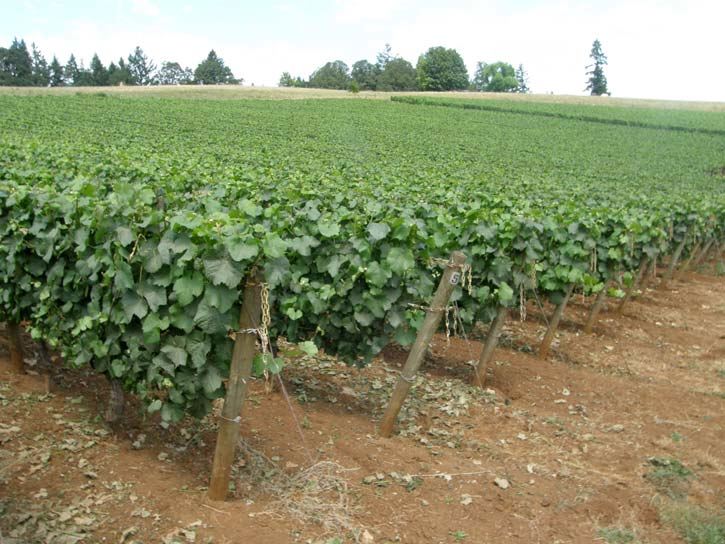
Privé Vineyard: French Flavor in the Chehalem MountainsIn 2006 I first made a journey to Privé Vineyard in Newberg, Oregon, with visions of Pinot Noir dancing in my head. My arrival was signaled by two aged wine barrels next to a sign reading, “Rue de Privé,” and I knew I had found a slice of France in the Chehalem Mountains. Behind a gate and straddled on the northern and southern side of a home sat two well-groomed one-acre vineyards. A sport court and a boules court surrounded by lavender indicated some fun was to be had here. Heading up the driveway, I was taken by the cutest little French-styled winery I had ever seen. The owners of Privé Vineyard, Mark and Tina Hammond, are American, but their Privé Vineyard is every bit French in name (“private or independent”) and character.
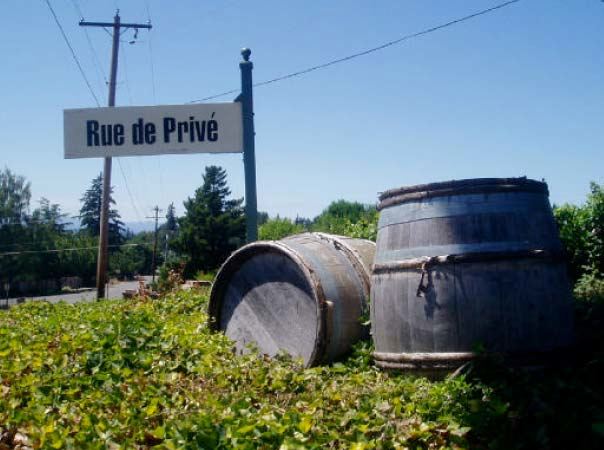 Privé Vineyard is a very small producer of Oregon Pinot Noir and is essentially a private winery for those lucky enough to be members of the winery’s allocation list. Mark is the vineyard steward and Tina is the winemaker, and together they produce the closest thing Oregon has to a cult Pinot Noir. The vineyard and winery are truly a family run estate, with outside help only enlisted to help pick grapes at harvest. The original Müller-Thurgau vines on the property were planted in Jory soil in 1980, and grafted over to Pinot Noir by the Hammonds beginning in 1995 with Pommard clone. The vines are meticulously farmed organically and yields are less than 2 tons per acre. In 2010 and 2011, the Hammonds made a conscious effort to pull back vigor and the resulting wines are more fruit forward. They believe that a subtle herbal note in the 2009 wines may have been secondary to excessive vigor. Four Pinot Noirs are currently released, three of which are estate grown. Le nord is from the upper, northern one acre, le sud is from the lower elevation, southern one acre, and a reserve named Joie de Vivre (Joy of Life) is crafted in half-barrel quantities and presented in an etched bottle. A Willamette Valley blend sourced from several Oregon Pinot Noir vineyards rounds out the lineup. Of the estate Pinot Noirs offered, le sud ripens faster and is picker at a slightly higher Brix, but in 2010 and 2011, the cooler vintages caused le nord to ripen quicker and that was picked at a higher Brix. The Willamette Valley blend was added in 2009 as an everyday wine that could be offered to visitors to the winery since the estate Pinot Noirs sell out quickly every year. The blend is a notch up in ripeness over the estate wines and more fruit-forward. Generally, three vineyards that meet the Hammonds’ high standards are sourced, but the vineyards change from year to year. The wine is very popular and they sell more of it than the le nord and le sud combined. The Hammonds’ business model is such that a bad vintage could severely hamper their income. Tina has begun to produce varietals other than Pinot Noir from sourced grapes to supplement their Pinot Noir output and meet her customer demands. She has been playing with Syrah from Walla Walla, Washington, of late and likes what she has produced. Tina likes to joke that if they had a miserable vintage at Privé Vineyard, Mark would have to get a real job. They kid each other about what each one would do. Mark thinks he might pump gas (required by gas station employees in Oregon) because he loves working outdoors. Tina is a self-taught winemaker who has a knack for crafting Pinot Noir. At the winery, grapes are carefully sorted by hand, 100% de-stemmed, not crushed, and fermented as whole berries in 1.25-ton plastic fermentation bins. A 5-day cold soak is usual. 100% new French oak barrels are used for le sud which is a more cellar-worthy wine, while le nord is aged in a combination of new (25%), 1, 2, and 3-year-old French oak barrels. I spoke with Tina recently about her tribulations with Brettanomycesin her cellar. She remarked that a winemaker must always fight to control it, and it began to appear in the Privé Vineyard wines in the 2005 vintage, when, as she notes, “It got away and the wines began to show a barnyard note.” Before that, the wines were pristine. It is not unusual for wine consumers to enjoy a little Brettanomyces in their Pinot Noir, but from a winemaker’s and wine critic’s perspective, it is usually undesirable. Beginning with the 2006 vintage, Tina took more intensive measures in the winery to control Brettanomyces, and has cross-flow filtered her wines for sterility. The Brettanomyces has disappeared from the wines, at least to my palate but I am not super sensitive to Brettanomyces. She feels more comfortable with the stability of the resulting wines and has found no significant differences between filtered and unfiltered samples of her wines except that the filtered samples were cleaner in appearance and had slightly brighter color.
Filtration is commonly employed in wines to both clarify and establish microbial stability. The most modern and preferred technique because of its gentleness is cross-flow filtration in which the wine runs parallel to a filtration membrane and is filtered by osmosis. A number of years ago filtration became controversial because Robert Parker, Jr., and others were outspoken proponents of unfiltered wine, claiming that filtration striped wine of its character and flavor. As a result, a number of producers who filtered their wines, did not admit to it. “Unfiltered” became a badge of quality and natural winemaking, and winemakers proudly displayed the word on their labels as a marketing tool. The truth is that properly performed modern day filtration has no effect on a wine's flavor. Jamie Goode (Authentic Wine 2011) noted, “We think that is wrong to think of filtration as solely an evil force in the wine world. It can in some cases lead to a more true expression of terroir in wines by eliminating microbes that can be the cause of faults.” At the recent Advances in Viticulture and Enology (RAVE) Colloquium, David Block presented a “flash paper presentation” titled, “The Effect of Filtration on the Sensory Properties of Red and White Wine.” Block teaches the winery equipment and design class at University of California at Davis. Veteran winemaker Curtis Phillips reported on the presentation in Wine Business Monthly (May 2012). Chemical and sensory analysis found no significant difference between filtered and unfiltered wines. A slight difference was found between wines analyzed right after bottling and wines analyzed at later times, presumably due to bottle shock. Phillips, who is in the “filtration” camp, commented that the experiment confirmed what he already suspected.
Tina was very excited about the 2010 and 2011 vintage Privé Vineyard Pinot Noirs, but curiously, she said that consumers tend to prefer the wines from Oregon’s warmer vintages like 2003, 2006 and 2009. The yields in 2010 were reduced ( 75% of the crop was lost), forcing her to raise prices for that vintage only. Yields in 2011 were half of a “normal” crop, but still considerably more than 2010. When you talk about passion for crafting wine, quality of life, and carving out a little niche of heaven, the Hammonds have got it right. Le nord or le sud, Privé Vineyard is the answer to Pinot Noir’s elusive kind of romance. Visit the website at www.privevineyard.com for more information and to sign up for the waiting list. You may find a bottle occasionally in the secondary market. Visits and tastings are by appointment (503-554-0464). I recently tasted a mini-vertical of Privé Vineyard Pinot Noirs from 2003 to 2010, and as you can see by my reviews, I am quite a fan of the wines. I buy some each year and they have become a cherished part of my wine cellar. Comparing le sud to le nord is a great lesson in terroir. A difference between le sud and le nord is evident in every vintage, independent of the difference in oak regimen. Ripeness varies between le sud and le nord, depending on the vintage and the character of the fruit (red versus dark red and black fruits) reflect this. The winemaking is consistent with the wines showing finesse, balance, soft tannins and admirable oak integration.
Summary of seven vintages tasted:
2003 Privé Vineyard le nord Yamhill County Estate Grown Oregon Pinot Noir 14.6% alc.. · Moderately dark plum color with mild bricking of rim in the glass. Aromas of fig, raisin, dried cherries, leather and a hint of port. Rich and plush on the palate with full-bodied flavors of dark plums, black currants and brown spice. Stately and velvety, with mild tannins and some length on the finish. Definitely showing its age and typical for a ripe wine in its later years. Drink up, don’t wait for decrepitude.
2004 Privé Vineyard le sud Yamhill County Estate Grown Oregon Pinot Noir 13.4% alc.. · Moderately dark reddish-purple hue in the glass. Intense aromas of black cherries with a hint of oak spice. Soft and round in the mouth with a middleweight core of dark red cherry and cranberry flavors, framed by gossamer tannins and zippy acidity. Finishes crisp and bright. At its apogee and should be drunk within the next few years. Very good.
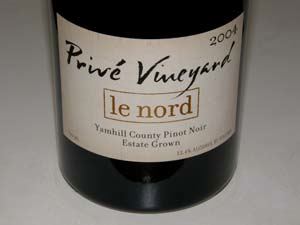 2004 Privé Vineyard le nord Yamhill County Estate Grown Oregon Pinot Noir 13.4% alc.. · Moderately dark reddish-purple robe. Restrained but appealing aromas of dark red stone fruit and raspberries with a hint of forest floor and leather. Delicious array of perfectly ripe fruits including black cherry, black raspberry and dark plum with a subtle savory herb underpinning. Moderately rich with soft tannins and good supporting acidity in perfect balance. Finishes with a mouth coating presence. This one will make your heart throb.
2005 Privé Vineyard le sud Yamhill County Estate Grown Oregon Pinot Noir 13.4% alc.. · Moderately dark reddish-purple color in the glass. Enticing aromas of fresh black cherries and spice are offset by a slightly unpleasant antiseptic, band aid aroma. Middleweight core of black cherry and black raspberry fruit that is slightly dumbed down with a subtle note of creosote, ending with a citrus-laden finish. A wine mildly flawed with Brettanomyces that is quite drinkable. Good.
2005 Privé Vineyard le nord Yamhill County Estate Grown Oregon Pinot Noir 13.4% alc.. · Moderately light and more red than purple in color. Aromas of burnt rubber, creosote, and horse stable with no fruit evident. Very soft in the mouth with markedly muted fruit flavors. A markedly flawed wine that is unsatisfactory to me, but some may find drinkable depending on their tolerance for Brettanomyces.
2006 Privé Vineyard le sud Yamhill County Estate Grown Oregon Pinot Noir 13.4% alc.. · Moderately dark reddish-purple robe. A warm growing season in Oregon and this wine reflects the vintage. Aromas of very ripe fruit and old oak cask. Full-bodied with flavors pushing the ripeness envelope including black raspberry, black plum, raisin, soy and brown spice, all caressed by supple tannins. A seamless wine that is well-crafted, but too ripe-fruited for my personal taste. Good (+).
2006 Privé Vineyard le nord Yamhill County Estate Grown Oregon Pinot Noir 13.0% alc.. · Moderately dark reddish-purple color in the glass. Muted aromas of dark plum, berry reduction sauce and pine. Luscious and ripe with a sense of sweetness. Flavors of black plum, currant and cola. Very seductive satiny mouthfeel. Definitely ripe fruited but does not cross the line and is not at all jammy. Very good (+).
2007 Privé Vineyard le sud Yamhill County Estate Grown Oregon Pinot Noir 13.4% alc.. · Light reddishpurple color in the glass. Nicely perfumed with aromas of well-spiced raspberries and cherries with a hint of herbs and straw. Light weight flavors of raspberries, strawberries and cherries accented with hints of sandalwood, cinnamon and herbs. An elegant wine that gives what it can considering the vintage. Still fine the next day from a previously opened and re-corked bottle. Very good.
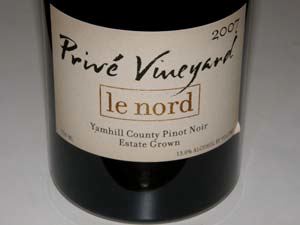 2007 Privé Vineyard le nord Yamhill County Estate Grown Oregon Pinot Noir 13.0% alc.. · Light reddish-purple color in the glass. Slowly emerging aromas of dark red and purple fruits with a hint of herbal oak. Medium weight flavors of black cherries, red plum and blueberries. Inviting finesse with a silky smooth mouth feel, impeccable balance and admirable length on the finish. Still terrific the next day from a previously opened and re-corked bottle. A little more body, length and overall appeal than le sud in this vintage.
2008 Privé Vineyard le sud Yamhill County Estate Grown Oregon Pinot Noir 13.4% alc.. · Medium reddish-color in the glass. Subdued nose upon opening, emerging very slowly in the glass to reveal scents of dark red berries and complimentary oak. A bevy of inviting dark red and black fruit flavors with some spice and tension (minerality). The fruit is buried in the wine’s structure and overshadowed a bit by the acidity, but when sampled the following day from a previously opened and re-corked bottle, the wine was significantly more fruit expressive and enjoyable. This wine deserves more time in bottle. Very good.
2008 Privé Vineyard le nord Yamhill County Estate Grown Oregon Pinot Noir 13.0% alc.. · Dark reddish-purple color in the glass. Very subdued nose, even with swirling. Middleweight oak-kissed plum and dark berry flavors with an appealing savoriness. Juicy and smoothly textured with mild tannins. Finishes with remarkable red berry aromatic intensity. Much more expressive and interesting the following day from a previously opened and re-corked bottle. Patience is required.
2009 Privé Vineyard Oregon Pinot Noir 13.5% alc. $30. · Moderately dark reddish-purple color in the glass. The fruit literally jumps out of the glass initially showing scents of black cherries and black raspberries. Over time in the glass, candied fruit aromas emerge along with a hint of raisin indicating very ripe fruit. Medium weight plum and black cherry flavors that initially are satisfying. Soft and smooth in the mouth. With time in the glass, the flavors veer to cooked fruit and raisin and I long for more acidity. This wine has the ripest profile of any of the estate wines. A well crafted wine that many will find enjoyable, particularly those that savor warm vintage fruit flavors. Good.
2009 Privé Vineyard le nord Yamhill County Estate Grown Oregon Pinot Noir 13.0% alc., $55. · Medium reddish-purple color in the glass. Very shy upon opening, slowly revealing aromas of dark red stone fruits and berries with a hint of oak. Rich, sumptuous and polished on the mid palate, offering flavors of dark red fruits including Bing cherries and ripe raspberries. An underpinning of savory herbs and oak adds interest. Very soft tannins with a velvety mouth feel, ending with a powerfully aromatic finish that goes on and on.
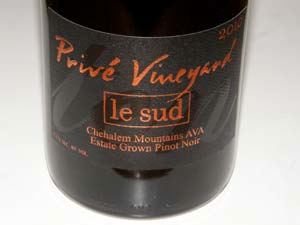 2010 Privé Vineyard le sud Chehalem Mountains AVA Estate Grown Oregon Pinot Noir 13.2% alc., $80. · Medium reddish-purple color in the glass. Strikingly aromatic featuring scents of ripe black cherries, black raspberries, black plums and dark rose petals. Retains aromatic intensity over time in the glass and I am wondering if it is possible to capture this aroma in a perfume. Very polished with moderately rich and glorious black cherry, black raspberry, cassis and cola flavors with perfect integration of oak, complimentary acidity, and soft, ripe tannins. The fruit hangs on like a 3-hour movie you don’t want to end. Very plush for a 2010 Oregon Pinot Noir. Still great the following day from a previously opened and re-corked bottle indicating age ability. A sensual pleasure that will persuade you to make Pommard your paramour.
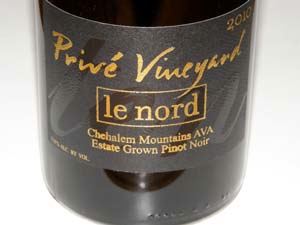 2010 Privé Vineyard le nord Chehalem Mountains AVA Estate Grown Oregon Pinot Noir 13.0% alc., $70. · Medium reddish-purple hue in the glass. Gorgeous nose featuring bright aromas of pie cherries, pie berries, and spice. Intense core of vibrant dark red plum, berry and cherry flavors, well-spiced. A very slight smoky, grilled note is evident. A little meatier than le sud and not as showy. Beautifully balanced with supple tannins, finishing long with intense black cherry aromatics. Rarely get fruit expression like this in the Willamette Valley, especially in 2010. Even though the wine has more vivid fruit, structurally it is lighter than the 2006 and 2008 vintages. Highly enjoyable.
Recent Willamette Valley Vintages: General Summaries
Harry Peterson-Nedry, Chehalem Wines
According to Greg Jones of the University of Southern Oregon, 2011 was between the 9th and 11th warmest year on record. Spring and early to mid summer were very cool and wet. More than 250 minimum temperature records were broke during that period and over 400 precipitation records were exceeded. Bloom in the Willamette Valley was in July! The crop was huge but it was feared that it would not ripen. The season turned around in September, which was one of the top three warmest Septembers on record in Oregon. September was also relatively dry so the fruit did ripen, and it was termed a “miracle harvest.” Most grapes were brought in under warm, sunny skies and there were only modest issues with birds and botrytis. Many vineyards were picked as late as the first week of November. Alcohols were generally low and about the same as in 2010, but the grapes had a surprising level of color and depth of flavor. The total harvest was 25% larger than 2010 and a new record for Oregon.
January and February were the warmest on record. Spring was very cool and wet. Greg Jones reported that from July through September and early October, temperatures were near normal to slightly cooler with fewer than normal heat spikes and normal rainfall totals. The season was similar to 2008 in cumulative growing degree day values. Most vineyards had to drop fruit to insure fruit ripening. Bird issues were a serious problem and began earlier than usual with some crops decimated. Harvest was delayed 2-3 weeks. The resultant wines had full flavors at lower Brix with brighter acidity although less color. Yields were reduced and overall production decreased by 22%, the lowest level since 2005.
A warm and sunny growing season that was warmer than 2008. There were some cool conditions in late September and early October, but most of the fruit came in at or near full ripeness. The ideal harvest wrapped up by the third week of October. The wines turned out fleshy but had better balance and freshness than the hot 2006 and 2003 vintages. The overall quality was superb and the wines were intensely fruited, showy, and somewhat forward. Very ripe fruit flavors are not uncommon. Alcohols were higher, with more acidity than in 2006. Plentiful yields.
The most perfect growing season ever in the Willamette Valley. Spring was late and cool, summer was cool, but the sun came out in early September and 7 weeks of sun ensued. The resultant wines are considered the best overall vintage ever for Oregon. They have impeccable balance, great structure, and impressive age ability. The wines are not easily approachable, even now, but those that are more forward are crazy good. Every pinotphile should have at least a few cases of the 2008 vintage in their cellar.
Wet, cool start to the growing season led to disease pressure. Good weather during set led to a fairly large crop. Rains started in late September which continued into October. Successful harvest was dependent on being able to pick between the major rains and thinning for a smaller crop. The wines were initially written off by many in the wine press. There were more large berries so more juice per ton and the resultant wines were less extracted than usual. Initially the wines were lean, but have taken on weight and complexity over time. Currently they are elegant and will age several more years. Generous yields.
 Source: National Agricultural Statistics Service (Nass.usda.gov), Oregonwine.org
Large Review of 2009 & 2010 Willamette Valley Pinot Noirs With a Few from 2008 & 2011
Critiquing Pinot Noir from Oregon, or California for that matter, is like splitting hairs. The quality is at an astonishing high level from a majority of producers and the highest rated wines are all to be recommended. I have taken somewhat of a jaundiced view of the numerical scores in today’s wine publications because there are too many Pinot Noirs rated 90 or above. Scores above 90 are so commonplace that they hold little significance. That said, there are more wines deserving of high accolades than ever before. This review offers an astonishing number of great wines. Especially noteworthy are the large number of outstanding Oregon Pinot Noirs priced at $35 and below. 2010, despite its challenging weather and low yields, has turned out to be one of Willamette Valley's greatest vintages. "Ten is Zen." Lush, ripe fruit at lower alcohol percentages with perfectly matched acidity and tannins. Stock up while the limited supply is still available. With the 2011 vintage, fifty years since the first Pinot Noir vines were put in the ground in the Umpqua Valley by Richard Sommer, Oregon Pinot Noir has entered the Golden Age. I have written a short summary for wineries I have not previously featured in the PinotFile. The wineries whose wines are reviewed here and are featured at this year’s International Pinot Noir Celebration include Anne Amie Vineyards, Cristom Vineyards, Domaine Serene, Luminous Hills, Rex Hill Vineyards and Winery, ROCO Winery, Scott Paul Wines, and Tyee Wine Cellars.
A to Z Wineworks
13.0% alc., $20, screw cap. · Moderately light garnet color in the glass. Aromas of oak-kissed cherries with a hint of spice and acacia. A fruity and uncomplicated wine with lighter weight flavors of red cherries and raspberries framed by bright acidity. Won’t turn your head, but pleasant and easy to drink. Decent.
Adelsheim Vineyards
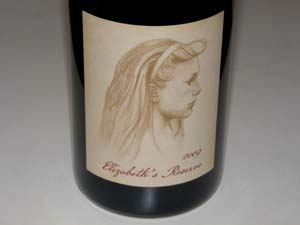 2009 Adelsheim Elizabeth’s Reserve Willamette Valley Pinot Noir 14.2% alc., $37.99. A barrel selection from some of the finest lots in the cellar. Mostly estate grown fruit. Named for Elizabeth Edel, the daughter of David and Ginny Adelsheim, the winery’s founders. The portrait on the label is by Ginny Adelsheim. · Moderately light reddish-purple color in the glass. The nose is complex and well endowed with vibrant aromas of dark red cherries, leather, dried rose petal and berry granola. Tasty essence of fresh black cherries and black raspberries with a lingering cherry and mineral driven finish. Delicately structured with crisp acidity and dusty tannins. Better the following day from a previously opened and re-corked bottle. Should be a cause for celebration in a few years. Very good (+).
Anne Amie Vineyards
2010 Anne Amie Vineyards Cuvée A Oregon Pinot Noir 13.3% alc., $25, screw cap. · Light garnet color in the glass. Delicate aromas of red cherries and berries with hints of nutmeg and oak. Light, bright and refreshing, with flavors of strawberries and cherries. Nimble with zingy acidity and very reserved tannins. A fine Saturday BBQ wine. Decent.
2009 Anne Amie Vineyards Willamette Valley Pinot Noir 13.9% alc., pH 3.56, TA 059, 2,600 cases, $35, screw cap. Released November 2011. Pommard and multiple Dijon clones. 100% destemmed, 7-21-day cold soak, extended maceration, on the skins for 28-40 days. Free-run and light pressings combined, racked to barrel and aged for 10 months in 21% new, 20% 1-year, and 50% neutral French oak barrels. The wine was aged 12 months before release. · Light reddish-purple color in the glass. Very appealing nose, with bright aromas of black cherries, black cap raspberries and even a hint of grilled peaches. Mid weight core of dark red cherries and berries picking up heft and interest over time in the glass. Well-balanced and easy to drink, with a pleasingly fruity finish. Good (+).
2009 Anne Amie Vineyards L’iris Willamette Valley Pinot Noir 14.1% alc., pH 3.63, TA 0.56, 260 cases, $75. Release date August 2012. Sourced from the finest blocks. Aged 18 months. Multiple vineyard sources including Anne Amie Estate. Clones are Pommard and Dijon 777, 115 and 828. 100% de-stemmed, 5-day cold soak, aged 18 months in 20% new, 40% 1-year and 40% neutral French oak barrels. Bottled unfined and unfiltered followed by extensive bottle aging. · Light reddish-purple color in the glass. Shy aromas of dark red, spiced berries and cherries. Elegantly composed flavors of black cherries, black raspberry jam and anise, lifted with bright acidity, wrapped in suave tannins, finishing long and smooth. The impression is one of finesse and nuance rather than power. Definitely age worthy. Very good.
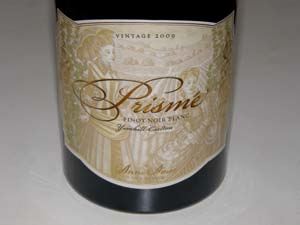 2009 Anne Amie Vineyards Prismé Yamhill-Carlton Pinot Noir Blanc 14.1% alc., pH 3.31, TA 0.59, 404 cases, $45, screw cap. Released May 2012. Sourced from Anne Amie Estate and Rainbow Ridge vineyards. Pommard and Dijon 115 clones. Aged 18 months in 25% new, 25% 1- year-old, and 50% neutral French oak barrels. Free run juice with no skin contact, entirely barrel fermented, lees stirred, and aged on the lees in oak barrels for 18 months. · Pale yellow color in the glass. Very aromatic with vivid scents of crème brulée, golden apples, buttered brioche, honeysuckle and baked pear. Substantial and delicious with full-bodied flavors of pear, white peach, golden apple, citrus, nutmeg and brown butter persisting on the generous and lengthy finish. Reminds one of Chardonnay but different. Creamy mouth feel with good underlying acidity. A remarkable wine that confirms the saying that Pinot Noir is a white wine masquerading as a red wine. Very special and quite unique.
Antica Terra Here is winemaker Maggie Harrison’s description of the 2010 vintage. “As we sat across from our accountant, a 30-year veteran of the industry and self-proclaimed Oregon wine visionary, he leaned comfortably back in his chair, cracked his knuckles, and with almost a gleam in his eye predicted it (2010) would be a ‘bloodbath’ for the Oregon wine industry. This moment and its surreal, cinematic quality captures the apocalyptic mood that attended our experience with the 2010 vintage. It felt like we were in the grasp of a once in a lifetime weather phenomenon. Everything we did in the vineyard, from the thinning of the first primordial clusters to the final uncertain strolls through the vine rows, assessing ripeness, was carried out in the context of a certain failure. As we sat with our families during the 4th of July festivities, we were still waiting for bloom and the accumulation of heat was gauged at 20-30 percent behind the ten-year average. The best guesses by local climatologists was a slim chance of equaling the ripeness achieved in even very cool vintages like 2005. The effect of all this on the Oregon wine community was palpable. We watched the sons and daughters of winemaking families bite their nails as they earnestly confided their concern that, ‘we might not make it through this.’ “ “Even as we basked in the warmth of the Indian summer that filled October, birds descended in pestilential numbers to decimate an already tiny crop and ominously punctuated the already uncertain mood. In retrospect, perhaps only the vines, with their biological desire for ripeness, knew better. If one takes a careful look at the past twenty years, one can see that the weather we experienced in 2010, is relatively normal. There are countless examples of terrifyingly cool growing seasons saved at the last instant by a few unexpected, balmy weeks at the end of October. Enduring this year after year, in an eerily repetitive scenario reminiscent of the movie, ‘Groundhog Day,’ each vintage as frighteningly intense as the last, is the essence of making wine in Oregon.” “As in 2008, yields were very low. Poor fruit set, combined with draconian thinning and the tariff exacted by birds, left us with less than half the wine to offer compared with previous years. But the wine that we have is exqusite. The 2010 wines share the concentration of 2008, but are slightly less tannic and about a half-degree lower in alcohol (13% as compared to 13.5%). This slight dip in alcohol translates into wines of perfect pitch that resonate more clearly than anything we have produced before. The experience of making these wines has shown us the beauty that can emerge when the weather pushes us and our vines further than we thought was possible.”
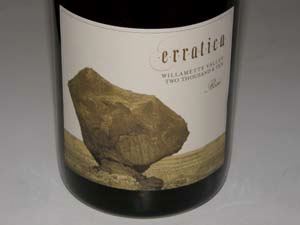 2010 Antica Terra Erratica Willamette Valley Rosé 13.0% alc., $50 (sold out). This wine has serious intentions, sporting a heavy bottle and wax top. Named for the giant rocks that are carried on the backs of glaciers and left to rest hundreds of miles from their true home. The juice is macerated on the skins for a little over a week. Between day 6 and 8, the aromatics of the fermentation reach a peak of expression and at this point, just before it becomes red wine, the juice is siphoned from the fermenters and sent to barrel, where the juice finishes its fermentation and ages on the lees for a year before bottling. In a conventional sense, this is not how rosé is produced. · Light orange-red color in the glass. Lovely and seductive on the nose, with delicate aromas of fresh strawberries, pomegranate, rhubarb, herbs, oak and even pear. Creamy and substantial, with vivid flavors of strawberries and red currants with a hint of oak-driven mocha and vanilla. Delicious and inviting, with a refreshing lift of acidity on the finish. A perfect compliment to grilled salmon.
2010 Antica Terra Willamette Valley Pinot Noir 13.0% alc., $50. This wine is based on fruit from the 11-acre Antica Terra Vineyard. · Moderately dark reddish-purple color in the glass. Aromas of fresh plums, violets, forest floor, tea, and toasty oak. Very soft and smooth in the mouth, with luscious flavors of black plums, blackberries, herbs and mocha java. Supple tannins and moderate acidity make for a pleasing palate experience. Very good.
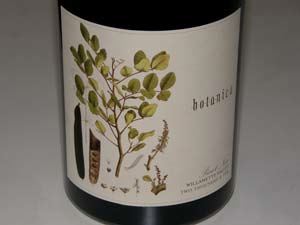 2010 Antica Terra Botanica Willamette Valley Pinot Noir 13.3% alc., $75 (sold out). Built around fruit from Shea Vineyard in the Yamhill- Carlton District where grapes are sourced from 8 acres of Pinot Noir split between East and West Hill. · Moderately dark reddish-purple color in the glass. Delicate aromas of black cap raspberries and plum sauce waif from the glass. Round, rich and Rubenesque, yet very smooth, seamless and light on its feet, offering delicious flavors of black plum, black raspberry and spice, caressed by gossamer tannins. Amazing flavor at a modest alcohol level. Perfect integration of oak and impeccable balance. Approachable now, but can go the distance. America, this is a Pinot Noir we can be very proud of. Winemaker Maggie Harrison is in it to win it!
Beaux Frères
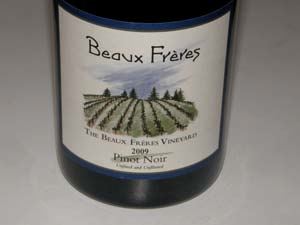 2009 Beaux Frères The Beaux Frères Vineyard Ribbon Ridge AVA Willamette Valley Pinot Noir 14.2% alc., $80. Large formats available. First released in 1991. Primarily Pommard and Wädenswil clones planted on their own roots between 1988 and 1995 in a 23-acre vineyard. Farming is organic and biodynamic and the vines are not irrigated. · Moderately light reddish-purple color and slightly hazy in the glass (unfiltered). Riper fruit profile with aromas of dark plums and berries with notes of peat, tea leaf, and sawdust. Medium weight core of dark red and black fruits with a subtle stem, brier and savory mushroom accent. Rather austere and unappealing upon opening, but considerably better the following day from a previously opened and re-corked bottle. Unique among Oregon Pinot Noir offerings for its “Burgundian” style with Oregon charm. Very good.
Beckham Estate Vineyard A small, family owned and meticulously farmed vineyard in Oregon’s Chehalem Mountains. The winery’s mission is to grow and craft exceptional Pinot Noir that expresses the beauty of the site and the individuality of the vintage. The vineyard is owned and farmed by Andrew and Annedria Beckham and Andrew does the winemaking. The vineyard is planted to Pommard, Wädenswil and Dijon 115 clones. The two wines reviewed here clearly reflect their respective vintages with the 2010 less ripe, lighter and more delicate, and the 2009 riper, darker fruited, and more structured. Ripe or less ripe, take your pick. Either way, this is a producer to put on your watch list.
2009 Beckham Estate Vineyard Chehalem Mountains Oregon Pinot Noir 14.9% alc., 250 cases, $32. Inaugural vintage. · Medium reddish-purple color in the glass. Aromas of darker fruits including black plum with a hint of toasted oak. Well-structured core of black raspberry, plum and black currant fruits with a hint of brewed tea, becoming more mellow over time in the glass. Very ripe, smooth and mouth filling with impressive length on the finish. Very good.
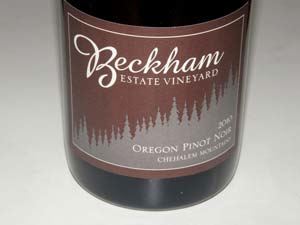 2010 Beckham Estate Vineyard Chehalem Mountains Oregon Pinot Noir 13.3% alc., 275 cases, $32. Released April 2012. Yields 2.5 lbs per vine. 100% de-stemmed, whole berry fermented, aged 11 months in 35% new French oak barrels. · Moderately light reddish-purple color in the glass. Very enticing aromas of fresh pie cherries, red plums and baking spices. Discreetly concentrated flavors of red cherries and berries with a hint of baking spice, offering hi-tone acidity and mild tannins, leaving a memorable fruit-filled impression on the finish. Lighter weighted than the 2009 bottling but offering more transparency, finesse and charm. Very good (+).
Big Table Farm
2010 Big Table Farm Willamette Valley Pinot Noir 12.5% alc., 203 cases, $38. Unfined and unfiltered. · Moderately light garnet color in the glass. Attractive aromas of red fruits, spice, sweet oak and pipe smoke. Light in weight with crisp and juicy red cherry and red berry flavors with farm-driven notes of tar, green garden and salinity. Decent.
2010 Big Table Farm Pelos Sandberg Vineyard Eola-Amity Hills Pinot Noir 12.9% alc., 146 cases, $45. Unfined and unfiltered. · Moderately light reddish-purple color in the glass. Perfumed with oak-kissed, fresh Bing cherries. Tasty core of dark cherries on a light and elegant frame with subtle notes of spice and oak. Finishes strong with a black cherry flourish. Good.
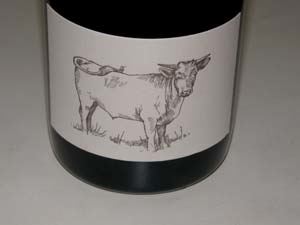 2010 Big Table Farm Resonance Vineyard Yamhill-Carlton Willamette Valley Pinot Noir 12.6% alc., 125 cases, $48. Label features Ronnie the steer at Big Table Farm. 75% whole cluster, aged sur lie in 30% new French oak barrels for 10 months. Unfined and unfiltered. · Moderately light reddish-purple hue in the glass. The nose is a little tight, but offers attractive scents of dark red cherries and strawberries. A transparent wine of great pedigree and delicacy, with inviting flavors of pie cherries and ripe strawberries caressed by supple tannins and crisped by bright acidity. A very charming wine that won’t knock your socks off with powerful extraction, but offers a gentile, extremely enjoyable drinking experience.
Brittan Vineyards
2009 Brittan Vineyards Gestalt Block Willamette Valley Pinot Noir 14.5% alc., $39. From an estate vineyard located on a south facing mountainside in the McMinnville AVA. · The dense, deep purple color in the glass shows what is to follow. Heady aromas of very ripe purple plum and black grapes. Lavishly fruited with more body than typical for Oregon Pinot Noir. Ripe, tooth-staining intensity with endless waves of sweet, purple fruit balanced by firm tannins and a vivid, citrus-driven acidity. Not for me personally, but done well in its style. Good.
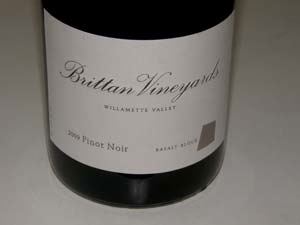 2009 Brittan Vineyards Basalt Block Willamette Valley Pinot Noir 14.3% alc., $39. · Moderately light reddish-purple color in the glass. Subdued aromas of dark red fruits, herbs and pine. Middleweight flavors of dark red cherries and berries with a hint of citrus on the finish. Softer, more restrained than the Gestalt Block bottling, offering a creamy texture and inviting drinkability. This is more to my liking. Very good.
Carabella Vineyard
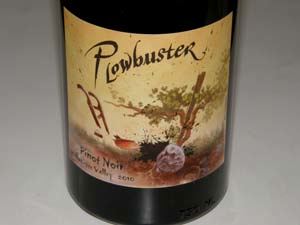 2010 Plowbuster Willamette Valley Pinot Noir 13.0% alc., $20. · Moderately light reddish-purple color in the glass. Aromas of cherries, strawberries and violets. The flavors echo the aromas in a moderately light style. A simple but pleasing wine that is soft in the mouth and finishes with a kiss of cherry. Consistently one of Oregon’s best valuepriced Pinot Noirs. Good.
Note: I was a bit shocked when I saw the alcohol percentages on the following two wines. I don’t recall seeing alcohol levels this high ever on an Oregon Pinot Noir although I am sure there were a number from the 2003 and 2006 vintages. I contacted owner Cara Hallock (spouse Mike Hallock is the winemaker) and she told me the following. “We too were shocked by our 2009 alcohol levels. In the Willamette Valley and at our site, we had an unusual 105 degree heat wave for a few days at the end of August. We are dry-farmed and 100% estate, so our wines are very true to the vintage. Irrigated vineyards were able to give the vines some water during the heat spike. We thought we would get bad reviews and that the customers wouldn’t be happy. But thankfully we got a good review from the Wine Advocate and many customers prefer the wines to our favorite, which is the 2008 vintage.”
2009 Carabella Estate Chehalem Mountains Willamette Valley Pinot Noir 15.7% alc., 350 cases, $37. Warm summer at this vineyard site. Pommard, Wädenswil and Dijon clones 113, 114 and 115 fermented separately. · Moderately light reddish-purple color in the glass. Lovely effusive nose composed of aromas of sweet Bing cherries, fresh raspberries, tea leaf and sandalwood. Delicious and intensely flavored black cherry bombast that is akin to Pinots from the warmer parts of the Russian River Valley. Despite its muscular nature, the wine retains a nimbleness and is neither roasted nor jammy. The alcohol never rears its head, but the acidity is slightly lacking on the relatively flat finish. A meal in itself that is hard to resist. Very good.
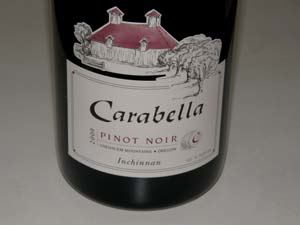 2009 Carabella Estate Inchinnan Chehalem Mountains Willamette Valley Pinot Noir 15.7% alc., 90 cases, $54. A select blend of 2 barrels of Wädenswil clone, 1 barrel of Dijon 115 clone and 1 barrel of Pommard clone. The name comes from the vineyard site, formerly part of the historic Inchinnan Farm, a hazelnut orchard still owned by the McDonald family. A select blend from the Carabella Estate Vineyard. · Medium reddish-purple color in the glass. More earthy and savory than the regular Estate bottling and more reticent to reveal its charms. The nose is well nuanced with aromas of black cherries, black raspberries, mushrooms, spice and graham. Dusty black cherry flavors are complimented by savory herbs. Well-proportioned tannins and acidity, and a touch more refined and sophisticated than the regular Estate bottling. Not at all ponderous. Even better the next day from a previously opened and re-corked bottle.
Cooper Mountain Vineyards
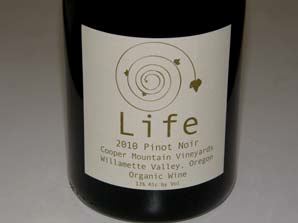 2010 Cooper Mountain Vineyards “Life” Willamette Valley Organic Wine 13% alc., pH 3.71, TA 0.55, 180 cases, $35 (sold out). No sulfites added during winemaking. Biodynamic® by Demeter®. Aged in 40% new French oak, unfined. · Medium reddish-purple color in the glass. Nicely perfumed with scents of fresh black cherries with a hint of grassy herbs and spice. Juicy and bright, with medium weighted flavors of dark red fruits including cherries, cranberries and even pomegranate. Crisp and refreshing with excellent tension. A different take on Pinot Noir that is quite pleasing and one of the best organic wines I have sampled. Good.
2010 Cooper Mountain Vineyards Reserve Willamette Valley Pinot Noir 13.5% alc., pH 3.52, TA 0.59, 2,100 cases, $24. Aged in 32% new French oak barrels. Made with organic and Biodynamic® grapes. · Moderately light reddish-purple color in the glass. Aromas are oak-driven and include brewed coffee and straw. Delicious core of cherries and red berries. Relatively light in weight with substantial oak and fruit tannins, finishing lively with some length. Crisp and juicy. The oak sheen overshadows the fruit at this stage. Less oak is evident the following day from a previously opened and re-corked bottle. If you pop the cork now, I recommend decanting. Should develop better integration of oak over time in the cellar. Good.
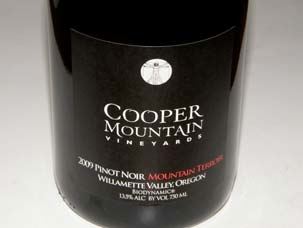 2009 Cooper Mountain Vineyards Mountain Terroir Willamette Valley Pinot Noir 13.2% alc., pH 3.65, TA 0.57, 290 cases, $45. Biodynamic® by Demeter®. Aged in 35% new French oak barrels. · Medium reddish-purple color in the glass. The nose veers to the ripper side with aromas of black fruits, plum cake, and oak. Delicious and luscious with mouth filling presence. Pure and polished with a generous core of purple and black fruits accented by anise (oak), spice and loamy earth, framed by well-balanced fine-grain tannins and acidity. This wine shows a little more oak that I would prefer at this stage, but the fruit purity is very striking. Will benefit from another year or two in the cellar. Very good.
Cristom Vineyards
2010 Cristom Mt. Jefferson Cuvée Willamette Valley Pinot Noir 14.0% alc., $24.99. Unfiltered. · Moderately light reddish-purple color in the glass. Aromas of black cherry and red berry jam on toast with a hint of wood spice, fading over time in the glass. Light in weight with an appealing crispness, offering a core of red cherries partnering with a subtle note of dusty sage and other savory herbs. The gripping tannins are mildly astringent and overshadow the fruit. Decent.
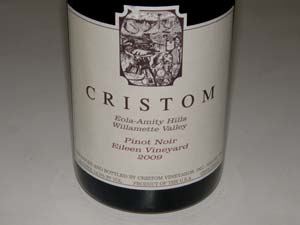 2009 Cristom Eileen Vineyard Eola-Amity Hills Willamette Valley Pinot Noir 14.5% alc., $44. · Moderately dark reddish-purple color in the glass. Rich aromas of red berry jam and cherry leather which are long and persistent. Delicious array of perfectly ripe fruits including black cherries, black raspberries and plum with well-proportioned tannins. A touch of spice rounds out the appealing flavor profile. Darkest in color and the most endowed wine in this vintage lineup for Cristom, this is a beautifully composed and balanced wine.
2009 Cristom Louise Vineyard Eola-Amity Hills Willamette Valley Pinot Noir 14.0% alc., $44. · Moderately light reddish-purple color in the glass. Aromas of dark red fruits, forest, and wood shop rise from the glass. Tasty core of dark red cherries and berries with a hint of stem. Builds in intensity over time in the glass. Plenty of body and backbone, with a mild grip of tannin, this is a seamless wine that has a way to go before it reveals itself. Very good.
2009 Cristom Jessie Vineyard Eola-Amity Hills Willamette Valley Pinot Noir 14.0% alc., $44. · Moderately light reddish-purple color in the glass. Nicely perfumed with scents of black cherries and dark red raspberries with a hint of oak. A gentle, comforting style, with lighter weight flavors of cherry pie filling and a hint of charcoal and spice. Soft in the mouth with noticeable length on the finish. Very good.
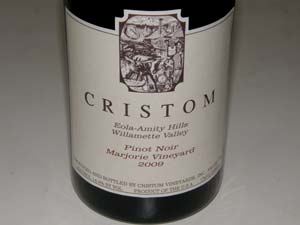 2009 Cristom Marjorie Vineyard Eola-Amity Hills Willamette Valley Pinot Noir 14.0% alc., $59. Planted on its own roots and the only vineyard resurrected rather than replanted when Gerrie obtained the property in 1992. 8-acres, 3 clones. Phylloxera has taken its toll so production is limited. 16th vintage. · Moderately light reddish-purple hue in the glass. The nose is well-fruited, showing aromas of red cherries, strawberries and spice. An elegant, feminine wine that is flat-out delicious. Middleweight flavors of dark red cherries and red berries, accented by the slightest oak and spice, and robed in firm but silky tannins. Very soft like the hair of an angel. In short, a party of velvet-edged red fruits.
Dion Vineyard Three generations have farmed Dion Vineyard, which provides premium wine grapes to a number of wineries throughout Oregon. Small quantities of wine are produced under the Dion Vineyard label. Located in the northern Willamette Valley, Dion Vineyard is 60 acres planted principally to Pinot Noir, Pinot Gris and Chardonnay. Some of the vines, rooted in Laurelwood soil, are over 30 years old. The owner and winemaker is Kevin Dion Johnson and the wines are vinified in McMinnville.
2009 Dion Vineyard Willamette Valley Pinot Noir 14.5% alc., 200 cases, $21. 4-day cold soak, inoculated, barrel aged in 33% new French oak for 13 months. 5 Pinot Noir clones from vines that are between 9 and 25 years of age. · Moderately light reddish-purple color in the glass. Aromas of wood-kissed cherries with a floral accent. Medium weight flavors of cherries, spice and sandalwood in a soft and sultry style with fine-grain tannins. An easy drinker. Decent.
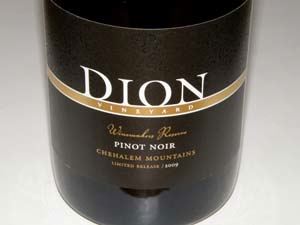 2009 Dion Vineyard Chehalem Mountains Reserve Pinot Noir 14.6% alc., 97 cases, $32. A 4-barrel selection aged in 50% new French oak barrels for 13 months. The barrels were selected for overall highest quality of the vintage as well as for the blend. First Reserve bottling. Clones 115, 667, 777 and 114. · Moderately light reddish-purple color in the glass. Nicely perfumed with fresh aromas of dark red cherries and berries with complimentary oak spice. Substantial flavors of dark cherries and berries wrapped in generous tannins. Very soft and seamless on the palate with welcoming hi-tone fruit on the big, persistent finish. Very good.
Dois Irmãos Winery This is a value-priced second label of Coelho Winery, an excellent producer of Willamette Valley Pinot Noir owned by Dave and Deolina Coelho. The wines carry Portuguese names reflecting the owners’ heritage. Brian Marcy of Big Table Farm is a consultant to Dave Coelho who is the winemaker.
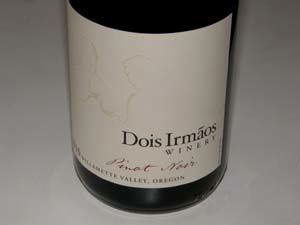 2010 Dois Irmãos Winery Willamette Valley Pinot Noir 13.2% alc., 2,058 cases, $40. Released March 2012. · Moderately light reddish-purple color in the glass. Alluring scent of fresh red berries, red plums and spice. Straight forward flavors of cranberries and red cherries with a touch of herbs. Mild fine-grain tannins and lively acidity. Lacks for a little intensity and ripeness which reflects the vintage, but is a fine daily drinker. Good.
Domaine Serene
2010 Domaine Serene Evenstad Reserve Dundee Hills Willamette Valley Chardonnay 13.4% alc., $55. Inaugural release. Only available through restaurants and boutique wine retailers. Composed of several different Dijon clones from estate vineyards in the Dundee Hills, primarily Cote Sud. Aged 17 months in 72% new French oak barrels. · Light straw color and clear in the glass. Lovely and delicate aromas of lemon curd and jasmine. Soft, even slightly creamy in the mouth, with pleasing flavors of pear and citrus zest with a very subtle oak underpinning. An understated wine of great charm, that teases gently with finesse. Very good.
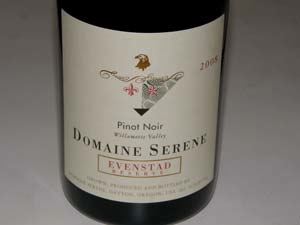 2008 Domaine Serene Evenstad Reserve Dundee Hills Willamette Valley Pinot Noir 14.1% alc., $65. The winery’s flagship wine sourced from estate vineyards in the Dundee Hills and Eola-Amity Hills. First vintage was in 1990. A blend of 40% Pommard, 51% Dijon, and 9% Wädenswil clones sourced primarily from estate vineyards grown in the Dundee Hills (70%) and Eola Hills (30%). Aged 17 months in 72% new French oak barrels. · Medium reddish-purple color in the glass. Upon opening, smoky oak and campfire aromas and flavors dominate the fruit. Tasted later in the day from an opened bottle, the wine had blossomed in an extraordinary fashion, with oak receding to the background as a pleasing mocha note, and luscious black cherry and black raspberry fruit marching to the forefront to saturate the mid palate with flavor. A satiny mouth feel leads to a generous, long, and dry finish. I suggest you decant this wine if opened now, or patiently cellar to allow the oak and tannins to further integrate. A great assembly of Pinot clones that will please any Pinot aficionado.
Dominio IV A producer of Biodynamic® and Demeter® family grown wines including Pinot Noir, Tempranillo, Syrah and Viognier at a winery located in McMinnville, Oregon. Most of the grapes are grown at the estate Three Sleeps Vineyard in Mosier, Oregon. The three principals are Patrick Reuter (winemaker), Leigh Bartholomew (vineyard manager) and Liz and Glenn Bartholomew (owners of Three Sleeps Vineyard). Dominio is Latin for a feast and Spanish for a territory or dominion. The IV refers to 4 people, 4 seasons, 4 climates, and 4 quadrants of the labyrinth. Each wine has a title, the meaning of which is related to its profile and may be anything from a song title to book. Visit www.dominiowines.com.
2009 Dominio IV The Slow Walk of the Wind Willamette Valley Pinot Noir 14.2% alc., $25. · Light and red-toned in the glass. Aromas of brier, oak, cut flowers, red licorice and rose petals with little fruit showing up. Moderately light core of cherry and red raspberry flavors with a slightly confected and vegetal tone. Pleasant, with mild tannins and easy quaffability. Decent.
2008 Dominio IV Pondering Ptolemy Willamette Valley Pinot Noir 13.5% alc., $32. Pommard clone. · Moderately dark reddish-purple color in the glass. Restrained aromas of dark red fruits with notes of sassafras, molasses and oak. Drinks lighter than expected by the color, offering a silky palate impression and reasonably good length on the finish. Features dark red berries and cherries accented by oak with lively acidity and ripe tannins. Like many Pinot Noirs from Oregon in the 2008 vintage at this stage, the wine is a bit closed and needs coaxing through decanting to fully reveal its charms. Good (+).
Evesham Wood Vineyard I did not get a chance to review the 2010 vintage wines of Evesham Wood but you get the idea of this producer’s quality from these outstanding 2009 Pinot Noirs. Winemaker Erin Nuccio of Evesham Wood has called 2010 the “Vintage of the Century.”
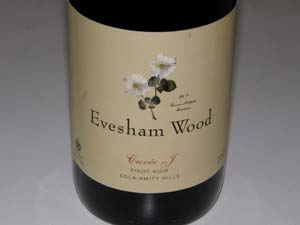 2009 Evesham Wood Cuvée “J” Eola-Amity Hills Oregon Pinot Noir 13.0% alc., $44. Made from organic grapes, Certified Organic by Oregon Tilth. Non-irrigated vineyards. Unfiltered. · Moderately light reddishpurple color in the glass. Plenty of Pinot singing on the nose with vivid aromas of black cherries, raspberries and a hint of herbs and spring bouquet. A cherry bombast with the slightest hint of herbs and oak in the background that supports rather than detracts. Impressive mid palate intensity with well-balanced t n’ a. A classy wine that is seamless and seductive. Still fine the following day from a previously opened and re-corked bottle.
2009 Evesham Wood Le Puits Sec Eola-Amity Hills Oregon Pinot Noir 13.0% alc., $36. From the 13-acre estate vineyard planted in 1986. Certified Organic by Oregon Tilth. · Moderately light reddish-purple hue in the glass. Brooding aromas of dark cherries and berries with riffs of forest floor and oak. The lightest weighted wine reviewed here, but plenty of signature Pinot flavors of dark cherries, plums, cassis and sage. Soft tannins with likable finesse, finishing bright and citrus-laden. Very good (+).
2009 Evesham Wood Illahe Vineyard Willamette Valley Pinot Noir 13.0% alc., $30. · Moderately light reddish-purple color in the glass. Aromas of oak-kissed black cherries. Bright and juicy with a core of earth-toned black cherries and raspberries with an underpinning of oak, tutti-fruity, and spice. Elegant with an uplifting finish. Needs time to full integrate the oak. Very good.
2009 Evesham Wood Temperance Hill Vineyard Eola-Amity Hills Oregon Pinot Noir 13.0% alc., $30. · Moderately light reddish-purple hue in the glass. A series of ever-changing aromas rise out of the glass including ripe dark cherries, fresh raspberry tart, sassafras and Herbs de Provence. The flavors echo the nose with a noticeable savory bent of pine, leaf and bramble. Plenty of nuance and character with remarkable aromatic persistence on the finish. Still great the next day from a previously opened and re-corked bottle. Very good (+).
Gresser Vineyard A family owned and run vineyard and winery located next to the Chehalem Ridge Natural Area southwest of Portland, near Forest Grove, Oregon. The vineyard is planted on a steep slope at about 900 feet elevation. The two Pinot Noirs reviewed here are from the estate vineyard which is farmed organically. The vineyard is planted to UCD 29 (a Jackson clone) and Dijon clones 113 and 115, making up a unique clonal mix for an Oregon Pinot Noir vineyard. The wines are extremely well priced considering the high quality. Visit www.GresserVineyard.com.
2009 Gresser Vineyard Chehalem Mountains Willamette Valley Pinot Noir 14.1% alc., 392 cases, $18. Released May 2011. UCD 29, Dijon 113 and 115 clones. Aged 16 months in 30% new French oak barrels. · Light reddish-purple color in the glass. Subdued aromas of black cherries and verbena. Lighter weight flavors of black cherries and cranberry with a hint of spice. Soft in the mouth with supple tannins and some length on the pleasing finish. Good (+).
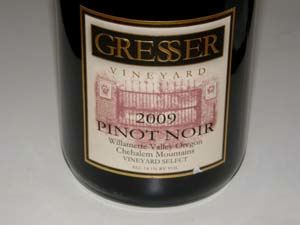 2009 Gresser Vineyard Vineyard Select Chehalem Mountains Willamette Valley Pinot Noir 14.1% alc., 246 cases, $24. UCD 29, Dijon 113 and 115 clones. Aged 16 months in French oak barrels. · Moderately light reddish-purple color in the glass. Nicely perfumed with the aroma of fresh dark red pie cherries. Delicious medium-weight dark red berry and black cherry flavors caressed by ripe tannins. Elegant with a very soft mouth feel and aromatic persistence on the long and flamboyant finish. An exceptional wine at this price point.
iOTA Cellars Iota means “small quantity” and represents the winery’s focus. Johanna and Don Sandberg moved from Minnesota to Portland in 1999 and the following year moved again to their vineyard site. Lynne and Perry Pelos, relatives and partners of the Sandbergs, also moved west from Minnesota to California and are involved in the vineyard and wine business. The Pelos Sandberg Vineyard is located in the northern Eola Hills of Yamhill County outside of Amity, Oregon. The property sits in the Van Duzer corridor. 11.5 acres are planted to Pinot Noir. The vines are non-irrigated and LIVE-certified. Grapes are currently sold to Rex Hill and Big Table Farm with some portion of the vineyard retained for the iOTA estate Pinot Noir. The 2009 wine reviewed below is the fourth vintage. This release, plus previous releases, can be purchased using the website order form at www.iotacellars.com.
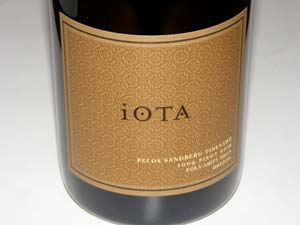 2009 iOTA Pelos Sandberg Eola-Amity Hills Willamette Valley Pinot Noir 14.2% alc., 476 cases, $36. Clones are Pommard, Wädenswil, and Dijon 777 and 667. The wine was aged for 10 months in 45% new 3-year air-dried French oak barrels and aged an additional year before release. · Medium plum-garnet color in the glass. Enticing aromas of freshly picked dark berries with a hint of oak (cigar box and toast). Inviting mid palate richness offering flavors of blackberries, marionberries and plum with a subtle note of tar and brier. Admirable finesse with a refreshing cut of acidity on the moderately long finish. Very good.
Kelley Fox Wines
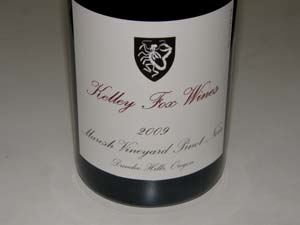 2009 Kelley Fox Wines Maresh Vineyard Dundee Hills Willamette Valley Pinot Noir 13.5% alc., $39, screw cap. Grapes are sourced from a block of the Maresh Vineyard planted in 1970. · Moderately light reddish-purple color in the glass. The nose makes you want to dive into the glass, offering hi-tone scents of fresh pie cherries, baking spice, graham and petrichor. Medium weight flavors of dark red cherries and raspberries with an oak sheen and a refreshing cut of citrus peel on the long finish. Soft, dreamy tannins and easy approachability, but displaying the balance to age. A feminine wine with curves. Very good.
Laura Volkman Vineyards
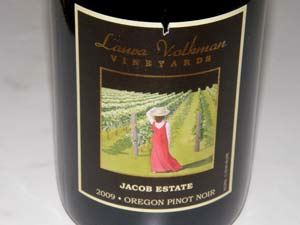 2009 Laura Volkman Jacob Estate Oregon Pinot Noir 13.7% alc., pH 3.70, 125 cases, $50. Clones 777, 115 and 114. Aged in 35% new French oak barrels. · Moderately light reddish-purple color in the glass. Brightly perfumed with aromas of black cherries, strawberries, spice and herbs. Delicious core of perfectly ripe black cherries with a hint of spice, truffle and sandalwood in the background. A magical wine that is soft on the palate, exhibiting impeccable balance, and finishing with a cherry-driven flourish that is dry, persistent and extremely satisfying. Drinking perfectly now.
Lenné Estate Steve Lutz has knocked it out of the ballpark in 2010. The wines are crafted by Owen Roe’s David O’Reilly, whose 2010 The Kilmore was reviewed in this issue and was ridiculously good. Steve is a dedicated farmer who produces wines from his special vineyard that seem to speak to me in every vintage.
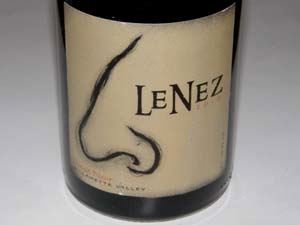 2010 Le Nez Willamette Valley Pinot Noir 14.0% alc.. Infant wine of Lenné. 100% estate fruit with same yields as Estate Pinot Noir. All five Pinot Noir clones planted at Lenné. · Moderately light reddish-purple color in the glass. Wood-kissed cherry and strawberry aromas with a hint of spice, rose petal and vanilla. Very showy aromatics. Middleweight flavors of black cherries with a subtle herb and spice accompaniment, backed by ripe tannins, complimentary oak and offering a velvety mouth feel. A highly approachable wine that is not an afterthought. Very good (+).
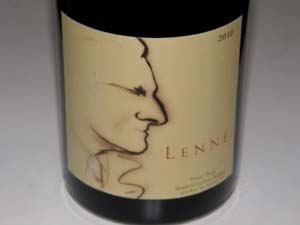 2010 Lenné Estate Yamhill-Carlton District Oregon Pinot Noir 14.0% alc.. The best barrels from each harvest. · Medium reddish-purple color in the glass. Enticing aromas of black cherries, darker berries, sassafras, sandalwood and coffee. Hits the palate with remarkable intensity, offering delicious, slightly sweet flavors of black cherries, black raspberries and ripe strawberries which persist on the long, dreamy, citrus-toned finish. Good structural bones and balancing acidity. 1 to 2 years from super stardom, although you can indulge yourself now.
2010 Lenné Estate Jill’s 115 Yamhill-Carlton District Oregon Pinot Noir 14.0% alc., 60 cases. · Medium reddish-purple color in the glass. Brooding, darker cherries and berries on the nose offering more pleasure over time in the glass. Full-bodied and highly pleasurable flavors of black plum and black raspberry wrapped in firm tannins and underpinned with complimentary oak. Speaks more of the soil. I am not usually a fan of single Dijon clone Pinot Noir, but this wine is a head turner.
2010 Lenné Estate Kill Hill Yamhill-Carlton District Oregon Pinot Noir 14.0% alc., 36 cases. · Moderately dark reddish-purple color in the glass. Clean aromas of dark berry jam and wine cellar. Ripe, fuller bodied flavors of blackberries and black cherries with some fig leather. Intense and mouth coating with a richly fruited finish. Big boy tannins need time to soften. A distinctive expression of this vineyard that will benefit from decanting if drunk now. Very good (+).
2010 Lenné Estate Karen’s Pommard Yamhill-Carlton District Oregon Pinot Noir 14.0% alc., 60 cases. · Moderately dark reddish-purple color in the glass. Deep aromas of black cherries and black raspberries with a hint of oak-driven toast and java. A luscious core of dark red and black fruits is powerful and ripe, wrapped in balanced tannins and brought to life with bright acidity. A riff of exotic Middle Eastern spices really perks up the palate. A very ageworthy wine that needs to shed some oak, but offers a mesmerizing drinking experience even now.
Luminous Hills Luminous Hills Vineyard is located in the southwestern portion of the Yamhill-Carlton District. While the appellation is known for sedimentary soils, Luminous Hills lies within a transition zone and overall, the vineyard is about 65% sedimentary and 35% volcanic. The foundation of the vineyard is Pommard with large blocks of Dijon clones 777, 667 and 115. The vineyard is farmed sustainably and is LIVE-certified. The owner and winemaker is Byron Dooley.
12.8% alc., residual sugar 0.18%, $21. Released April 6, 2012. Pommard and 777 clones. Aged in 67% neutral French oak barrels. A combination of direct press and saignée off the lots from the same sections of the vineyard. · Very pretty pink-orange color in the glass. Aromatically pleasing with scents of fresh strawberries and raspberries with a hint of pink grapefruit. Delicate but flavorful, with a mild refreshing tartness. The core of strawberry, raspberry, and blood orange flavors is framed by discreetly firm tannins and the dry finish has surprising length. A serious rosè that has some perseverance. Very good.
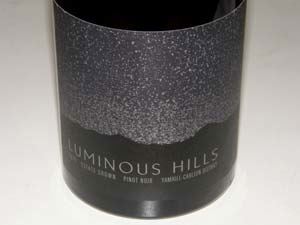 2010 Luminous Hills Estate Grown Yamhill-Carlton District Willamette Valley Pinot Noir 13.5% alc., 329 cases, $28. Released February 15, 2012. 115, 667, 777 and Pommard clones. Low yielding vintage. · Moderately light reddish-purple color in the glass. Aromas of perfectly ripe black cherries, tea leaf and stem waif from the glass. Delicious essence of black cherries with riffs of black raspberries and spice. Full-flavored and sensuous, with pinpoint balance and a special finish in which hauntingly aromatic cherries return for what seems like an eternity. Kissed by an angel.
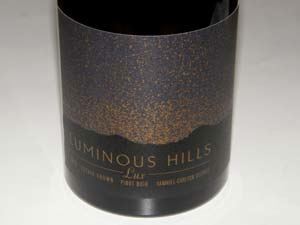 2010 Luminous Hills Lux Estate Grown Yamhill-Carlton District Willamette Valley Pinot Noir 13.5% alc., 112 cases, $35. Released February 15, 2012. Exclusively Pommard and 777 that combines dark fruited notes from the Pommard on lower elevation sedimentary soil coupled with the intense redder fruits of the 777 on the upper elevation Jory soil. The two clones were co-fermented. Aged in 23% new French oak barrels. · Moderately light reddish-purple color in the glass. Hi-tone and pure aromas of black cherries and black raspberries. Delicious mid palate fruit offering a mélange of dark red and black berries, stone fruits and black grapes. Supple tannins make for easy drinking now. Impeccable balance and very polished. Hard to top the Estate Grown bottling, but this one does with slightly more flavor and length. Crazy good at a modest price. Will be one of my 2012 All-Americans.
Lumos Wine Company Dai Crisp and his spouse PK McCovy launched the Lumos Wine Company in 2000. Since 1999, Crisp has been managing Temperance Hill Vineyard, an 100-acre site in the Eola Hills. Grapes are sourced from the family’s home Wren Vineyard, Rudolfo Vineyard and Temperance Hill Vineyard, all of which Crisp manages using organic-based fertilizers, certified organic fungicides and mechanical cultivation rather than herbicides. Lumos is the first Food Alliance Certified Winery making wine only from Food Alliance Certified vineyards in Oregon. Lumos shares winery space with Dominio IV in McMinnville.
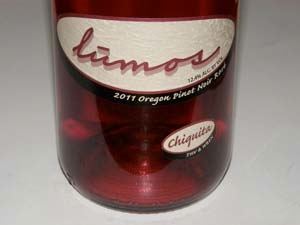 2011 LUMOS Chiquita Oregon Pinot Noir Rosè 12.4% alc., 114 cases, $20. From Wren and Temperance Hill vineyards. · Medium rosy red color in the glass. Enticing summer perfume of fresh strawberry glaze, red cherries, blood oranges and pine. Fresh and tangy with good body and substance for a rosè. Flavors of strawberries, tart cherries and a hint of citrus with a lively cut of acidity on the refreshing finish. Very good.
2009 LUMOS Five Blocks Willamette Valley Oregon Pinot Noir 14.1% alc., 504 cases, $24. Aged 15 months. · Medium reddish-purple color in the glass. Primarily cherry aromas which build in intensity over time in the glass. Tasty mid weight flavors of dark cherries and raspberries with hints of cola, cocoa and spice. Juicy and refreshing with supple tannins and well honed acidity. A pleasure to drink. Very good.
2008 LUMOS Temperance Hill Vineyard Eola-Amity Hills Willamette Valley Pinot Noir 688 cases, 13.6% alc., $32. · Moderately dark reddish-purple color in the glass. This is a curious wine because upon opening it has very attractive ripe, rich fruit aromas and flavors, but over time oak and peppery notes take over and it loses some appeal. Sweet black raspberry and black cherry flavors dominate, framed by lively acidity and firm tannins. Delicious upon opening with impressive length, the wine becomes ponderous and rather ordinary over time. Tasted twice with the first bottle unappealing due to marked reduction and dominate oak presence. Second bottle is Good.
Owen Roe Winery
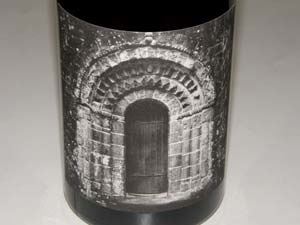 2010 Owen Roe The Kilmore Yamhill-Carlton District Oregon Pinot Noir 13.0% alc., 988 cases, $42. Sourced from Lennè and Merriman vineyards. Aged in 33% neutral, 39% 2-year and 28% 1-year French oak barrels. Pommard, Wädenswil and Dijon Clones. · Medium reddish-purple color in the glass. Subdued but very pleasing aromas of black cherries, black raspberries, plum and violets. Hits the mid palate with enormous tenacity, offering delicious black raspberry, marionberry, cola and vanilla cream flavors which linger on the spiced, fruit-scented finish. Very soft and alluring in the mouth. Plenty of Pinot singing in this sensational wine that is ready to drink now.
Penner-Ash
2009 Penner-Ash Willamette Valley Pinot Noir 14.5% alc., $40. · Moderately light reddish-purple color in the glass. Aromas of raspberry preserves jump out of the glass and hold on over time in the glass. Delicious array of dark red cherries and berries, especially black cap raspberries. Seamless and elegant with mild tannins and easy approachability. I really liked this Willamette Valley blend which is one of the best I have tasted from this or any vintage. Impressive length for a blend. Very good (+).
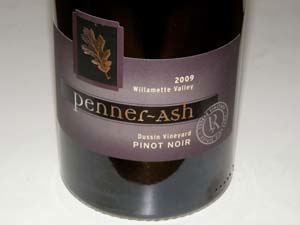 2009 Penner-Ash Dussin Vineyard Willamette Valley Pinot Noir 14.5% alc., $50. From a vineyard adjacent the winery in the Yamhill- Carlton District. Volcanic and sedimentary soils. · Moderately light reddish-purple color in the glass. Subdued, but pleasant aromas of dark red and black berries with complimentary notes of forest and timber. Mid weight flavors of black cherries supported by moderate fine-grain tannins and perfectly matched acidity. A highly enjoyable and sophisticated offering that is potentially better and more age worthy than the Willamette Valley bottling. Like all great wines, it takes on more interest and intensity with time in the glass. A seamless, serious wine of endless charm.
Ponzi Vineyards
2010 Ponzi Vineyards Tavola Willamette Valley Pinot Noir 13.5% alc., 5,900 cases, $25, screw cap. Released October 2011. Sourced from seven estate vineyards and includes fruit from sustainably-grown vineyards in the Willamette Valley. 100% de-stemmed, extended cold soak, native yeast fermentation, light pressing just before dryness to ensure a softer, fruit-forward style. Aged for 11 months in 25% new French oak barrels. Bottled without fining and filtration, and aged in bottle for 5 months before release. · Moderately light reddish-purple color in the glass. Pleasant and nuanced on the nose, displaying aromas of redder fruits including raspberries, rose petals, and subtle oak. Medium weight array of sweet red Pinot fruits with a riff of savory herbs. Mild tannins and silky in the mouth. A good introduction to Oregon Pinot Noir. The day I sampled this, it was 90ºF, and after reviewing the wine, I put some ice cubes in my glass. This blunted the aromatics but softened the tannins and brought out the fresh red raspberry and red cherry flavors. Good.
2009 Ponzi Vineyards Willamette Valley Pinot Noir 13.8% alc., 5,350 cases, pH 3.69, $35, screw cap. Released April 2011. Sourced from 10 vineyards with the largest portion from Ponzi’s Aurora Vineyard (38%). 100% de-stemmed, 5-day cold soak, lightly pressed at dryness. Aged 11 months in 30% new French oak barrels and bottled without fining or filtration. · Moderately light reddish-purple color in the glass. Reasonably intense aromas of fresh dark plums and berries with a hint of oak and violets. Light in weight, but quite flavorful, with an array of blue and black berry flavors, enhanced by supple tannins and well-honed acidity. A solid, dependable wine year in and year out. Good (+).
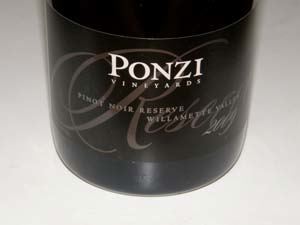 2009 Ponzi Vineyards Reserve Willamette Valley Pinot Noir 14.0% alc., pH 3.65, 1,350 cases, $60. Released September 2011. A blend of LIVE Certified Sustainable fruit from Ponzi’s Aurora, Madrona and Abetina vineyards, as well as fruit from Linda Vista, Lazy River, Gemini and Lemelson vineyards. 100% de-stemmed, 5-day cold soak, 7-day post fermentation maceration. Aged 20 months in 50% new French oak barrels, then racked and bottled by gravity without fining or filtration. The wine was aged for 5 months in bottle before release. · Light garnet color in the glass. Brooding aromas of ripe dark red cherries and berries with a hint of forest floor and flint. Delicious core of wellripened dark red and purple stone fruits and berries supported by firm fruit tannins and framed by uplifting acidity. Silky in the mouth and easy to drink, with some finishing persistence. Not a blockbuster, but enough core fruit to draw your attention. Will benefit from further bottle aging and has excellent long-term aging prospects. Very good.
Purple Hands Owner and winemaker Cody Wright is the son of noted Oregon winemaker, Ken Wright. His stepfather, Rollin Soles, runs Argyle Winery, and his mother, Corby Stonebraker-Soles, now married to Rollin, is a partner in ROCO Winery. Cody grew up in the Williamette Valley and worked at wineries in Oregon, New Zealand and Australia. He now divides his times as assistant winemaker at ROCO Winery and his own label, Purple Hands. The Purple Hands name and label reference the contrast between winemakers’ wine-soaked cellars, clothes and hands, to formal attire that winemakers don for wine events. The label for the Purple Hands Pinot Noir comes from a black and white photo of Ken Wright and Mike Etzel at a tuxedo dinner depicting their purple-etched hands contrasted with their tuxedos. Purple Hands wines are sold online at www.purplehandswine.com.
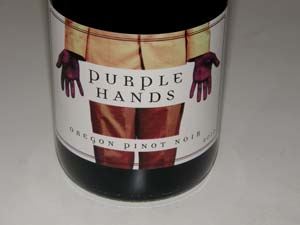 2010 Purple Hands Oregon Pinot Noir 13.5% alc., pH 3.69, $30, screw cap. Sourced from Stoller Vineyard in the Dundee Hills. Clones are Wädenswil and 777. 95% de-stemmed, 6-day cold soak, aged 9 months in 10% new and 90% neutral French oak barrels. · Moderately light reddish-purple color in the glass. Very aromatic with bright scents of dark cherries and berries, plum, wood spice and herbs. Medium weight flavors of brandied cherries, red plums and savory herbs. Juicy and crisp with mild tannins and an uplifting finish. Good (+).
Rex Hill Rex Hill is celebrating 30 years in the Willamette Valley. Founded by Paul Hart and his wife Jan Jacobsen, they retired in 2007 and sold the winery to A to Z Wineworks, a winery owned by Bill and Deb Hatcher, Cheryl Francis, and Sam Tannahill.
2009 Rex Hill Reserve Willamette Valley Pinot Noir 14.0% alc., pH 3.62, TA 0.54, 369 cases, retail $48, available at $34.99. The best fruit and ensuing wines from prized vineyard sources around Oregon’s Willamette Valley (Jacob-Hart, Sims, La Colina and Roserock). Aged 11 months in French oak barrels. · Moderately light reddish-purple color in the glass. Bright and fruity on the nose out of the gate offering aromas of very ripe dark fruits. Middleweight core of black plum, black raspberry and blackberry flavors with a complimentary hint of spice and oak. Silky on the palate with well-honed tannins and some length on the finish. A fruit-driven wine that veers to over ripeness (especially evident the following day from a previously opened and re-corked bottle), but will appeal to those who welcome this flavor profile. Good.
ROCO
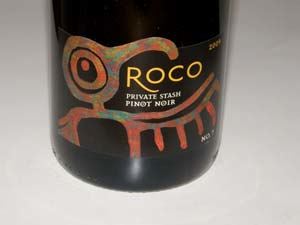 2009 ROCO Private Stash No. 7 Wits End Vineyard Chehalem Mountains Pinot Noir 14.0% alc., 250 cases, $70. · Medium reddishpurple color in the glass. Deeply aromatic, filling the glass with scents of deep black cherries, plum, raisin and cut flowers. Hits the mid palate running and keeps on going. Striking fruit intensity and purity, exhibiting flavors of black raspberries, black cherries and black currants that linger on the generous finish. The flavor profile veers to the ripe (dark) side, but never enters overripe territory. Still sporting substantial tannins and will benefit from a few years in the cellar. Always a distinguished wine and this vintage is no exception.
Scott Paul
2010 Scott Paul Audrey Dundee Hills Oregon Pinot Noir 13.1% alc., $69, screw cap. A barrel selection of the finest, most elegant, silkiest wine in the cellar. Sourced from the winery’s blocks at Maresh and Nysa vineyards. · Light garnet color in the glass. Delicate but attractive scents of red cherries, herbs, oak and straw. Soft, elegant and charming in the glass with layers of red cherry, strawberry, red raspberry and cranberry fruits. A delicate, subtle wine with gossamer tannins that reflects the vintage and achieves the winery’s goal beautifully. Did I say elegant? Very good.
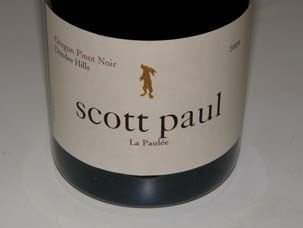 2009 Scott Paul La Paulée Dundee Hills Oregon Pinot Noir 13.1% alc., $32, screw cap. Finest lots of the vintage from the winery’s blocks of Maresh Vineyard. Indigenous yeast fermentation. Aged 10 months in 20% new French oak barrels. Bottled unfined and unfiltered. · Moderately light deep red color in the glass. Lovely perfume of dark cherries, herbs and mocha java. Plenty of body and weight with multiple layers of fruit that really jump out. Rich flavors of fresh dark cherries, raspberry coulis, mocha and sandalwood with gossamer tannins, bright acidity and easy drinkability. Could use a little more time in the cellar to shed its oak sheen but very hard to resist now. Pick any superlative you want.
2008 Scott Paul La Paulée Willamette Valley Pinot Noir 13.5% alc., $32, screw cap. Finest lots of the vintage from Maresh, Ribbon Ridge and Momtazi vineyards. · Medium garnet color in the glass. Demure nose initially, picking up intensity over time in the glass, offering aromas of red cherries, red strawberries and herbs including sage. Middleweight core of red Pinot fruits with a hint of spice and oak wrapped in firm but caressing tannins, finishing with impressive fruit intensity. Seductively soft in the mouth. Suggest decanting if you choose to drink now. Very good (+).
Seufert Winery A boutique winery located in Dayton, Oregon, specializing in vineyard-designated Pinot Noir from purchased grapes. The owner and winemaker is 4th generation Oregonian, Jim Seufert. Vineyard sources are top notch and prices are reasonable. For more information and to purchase, visit www.seufertwinery.com.
2009 Seufert Vista Hills Vineyard Dundee Hills Willamette Valley Pinot Noir 13.6% alc., $35. · Moderately light reddish-purple color in the glass. Complex array of aromas including red cherries, spice, oak, pine, and sandalwood. Soft in the mouth with a core of red cherry flavor accompanied by a savory mushroom, pine and herbal accent. An interesting farm-driven wine with silky tannins and easy drinkability. Good.
2009 Seufert Winery Bishop Creek Vineyard Yamhill-Carlton District Willamette Valley Pinot Noir 13.5% alc., $30. · Medium reddish-purple color in the glass. Bright aromas of fresh black cherries with the slightest hint of herbal oak. Mid weight core of earth-kissed black cherries backed by firm, fine-grain tannins and offering a flavor packed, lush and lengthy finish. Very good.
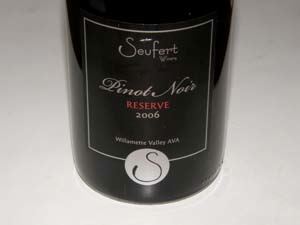 2006 Seufert Winery Reserve Willamette Valley Pinot Noir 13.9% alc.. · Moderately dark reddish-purple color in the glass. Ripe fruit aroma profile that takes some coaxing to emerge. Delicious and substantial core of black cherries, black raspberries and plum sauce supported by husky tannins. Bright acidity brings the fruit into focus and balances the tannins, and contributes a citrus toned berry finish of some length. A thoroughly enjoyable drink that beautifully reflects the warm vintage, displaying its good points (ripe, luscious fruit) without its bad qualities (high alcohols, over ripeness).
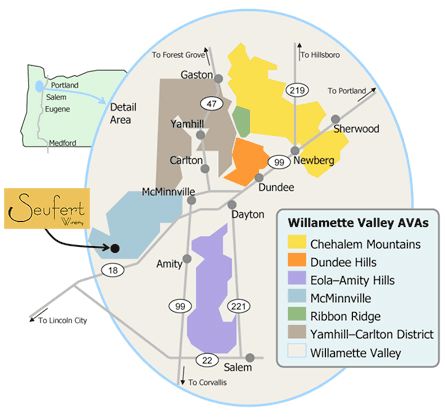 Seven of Hearts Byron Dooley crafts marvelous wines from both his estate Luminous Hills Vineyard and sourced fruit under the Seven of Hearts label.
2010 Seven of Hearts Willamette Valley Pinot Noir 13.5% alc., 469 cases, $20. Pommard, Wädenswil, and Dijon 114, 115, 667 and 777 clones sourced from several Willamette Valley sub- AVAs. Aged in 22% new French oak barrels. · Moderately light reddish-purple color in the glass. The nose is nicely fruited with aromas of dark red and black stone fruits and berries. Earthbound flavors of black raspberries, black cherries and plums wrapped in firm supporting tannins, finishing with a fruit-driven flourish. A solid wine for everyday drinking. Good (+).
2010 Seven of Hearts Lia’s Vineyard Chehalem Mountains Willamette Valley Pinot Noir 13.5% alc., 77 cases, $35. This prized vineyard was formerly known as Jacob-Hart. This blend is a coferment of some of the vineyard’s oldest and best blocks grown on Jory soil. Pommard, Wädenswil and Mariafeld (UCD 23) clones. Aged in 22% new French oak barrels. Released March 15, 2012. · Light in color. Subdued but teasing array of red Pinot fruit aromas. Light and elegant core of tasty darker raspberry and cherry fruit with a hint of spice and sandalwood. Opens nicely in the glass with ever-expanding flavor. Supple tannins make for easy drinking now. Very good.
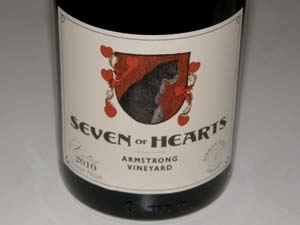 2010 Seven of Hearts Armstrong Vineyard Ribbon Ridge Willamette Valley Pinot Noir 13.5%alc., 98 cases, $35. Released March 15, 2012. Vineyard farmed by owners Dough and Michelle Ackerman. 50% Pommard and 50% 666 with 67% whole cluster fermentation. · Moderately light reddish-purple hue in the glass. Very bright and enticing aromas of fresh berries and rose petals. Big-boned core of purple and black berries and black plum with a subtle oak underpinning. The fruit is overshadowed by the prodigious tannins now, but there is enough fruit presence to grab your attention. More body and fruit than the Lia’s. Needs more time in the cellar, but very promising. Very good (+).
Siltstone Joel Myers is mentioned in the first article in this issue about the “Coury clone.” In 1979, he graduated from the University of Oregon with a degree in Geography and Environmental Science. His first job was a harvest position in the vineyard owned by David Lett at The Eyrie Vineyards. He subsequently became a full-time vineyard and cellar manager. Joel met Louise Bernards, a teacher and artist from a local farm family, who was working for the Letts as well. They were married in 1981, and traveled to Switzerland, where Joel worked with Dr. Werner Koblet, David Lett’s colleague from University of California at Davis. Koblet was one of Europe’s leading researchers in viticulture. Joel developed extensive knowledge of vine physiology, disease control, and clones and returned to Oregon with a renewed interest in the potential for Oregon viticulture. In 1984, he founded Vinetenders, a company specializing in vineyard management. Vinetenders currently manages over 500 acres of prime vineyard property in the northern Willamette Valley. Joel launched his label, Siltstone, with the 2000 vintage and has carried on the brand successful with his wife Louise, and sons Joey, John and David. The wines are sourced from Guadalupe, Blacktail and Hyland vineyards and include Pinot Noir, Pinot Gris and Riesling. The wines are sold by contacting john Myers at 971-241-2548. The website is www.stilstonewines.com.
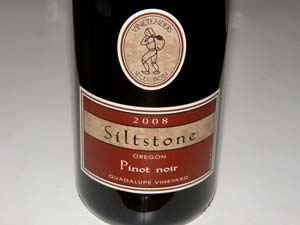 2008 Siltstone Guadalupe Vineyard Oregon Pinot Noir 13.2% alc., 380 cases, $28. Released May 2011. Viticulturist Joel Myers’ own label. His company, Vinetenders, manages Guadalupe Vineyard for owners Jim Stonebridge and Kathleen Boeve. · Moderately light reddish-purple color in the glass. Evocative aromas of red berries and cherries on a bed of mesquite. Vibrant flavors of red raspberries and Bing cherries with a hint of caramel and spice that fan out nicely on the palate in an elegant presentation. Very forward for this vintage. Long, scented aftertaste. An exceptional wine of great pinotosity.
Sineann Cellars
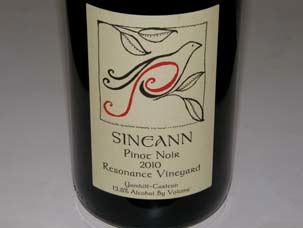 2010 Sineann Resonance Vineyard Yamhill-Carlton District Oregon Pinot Noir 13.8% alc., 400 cases $42, Vino-Loc glass closure (love this!). Small crop, low production. Vineyard farmed by Kevin and Carla Chambers using biodynamic techniques. · Medium reddish-purple color in the glass. Aromas of red berries, red cherries, potpourri and the slightest oak. Herb-flecked red berry flavor in a light and elegant style finishing savory and juicy. Velvety in the mouth and long and ephemeral on the finish. A delicate wine, yet flavorful, offering immense charm.
Stevenson-Barrie
2008 Stevenson-Barrie Freedom Hill Vineyard Willamette Valley Pinot Noir 13.8% alc., $32. The Duschee Family planted this vineyard in 1982. Produced and bottled by Panther Creek Cellars in McMinnville. · Medium reddish-purple color in the glass. Aromas of dark red cherries, black raspberries, brier, oak and spice. Earthy, slightly smoky, dark red fruited with an oaky edge. Mid weight core with firm tannins and very good length. Hard to get my arms around this wine, but may blossom with more time in the cellar. Good.
2008 Stevenson-Barrie Temperance Hill Vineyard Willamette Valley Pinot Noir 14.0% alc., $32. · Marked reduction with aromas of sulfur, burned wood, and flint. Black cherry flavor backed by firm tannins and a significant oak underpinning, showing a sulfur hangover on the finish. Re-tasted the next day from a previously opened and re-corked bottle, the wine was unchanged and still significantly reduced.
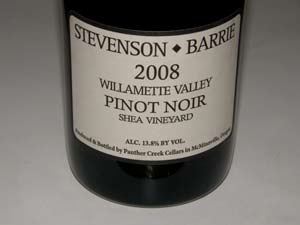 2008 Stevenson-Barrie Shea Vineyard Willamette Valley Pinot Noir 13.8% alc., $32. · Medium reddish-purple color in the glass. Subdued aromas of black fruits with a hint of herbs. The dark red and black berry core has some charm but is imprisoned in tannins at this point. Pretty linear now, and in need of a few more years in the cellar. About the same the following day from a previously opened and re-corked bottle. The best of the 3 Stevenson-Barrie wines tasted here. Good (+).
Tyee Wine Cellars
2009 Tyee Wine Cellars Estate Willamette Valley Pinot Noir 13.5% alc., $23.99. · Moderately light reddish-purple color in the glass. Well perfumed with aromas of black cherries, bark, balsam, rose, sage and spice. Brisk and lively on the palate with medium weight flavors of black cherries and black raspberries backed by ripe tannins and offering some staying power on the finish. Good (+).
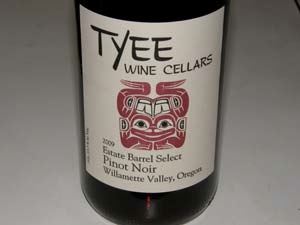 2009 Tyee Wine Cellars Estate Barrel Select Willamette Valley Pinot Noir 13.5% alc., $34.99. · Moderately light reddishpurple robe. Reserved but enticing aromas of a bowl of crushed dark red cherries, plums and berries. A very polished wine with grace and elegance, yet offering a substantial rush of sinfully delicious and perfectly ripe dark red cherries and berries that persist on the crisp and juicy finish. Combines power with finesse. Youthful, and will benefit from more time in the cellar. Not the blockbuster that the 2008 vintage was, but very representative of the vintage.
Westrey Wine Company
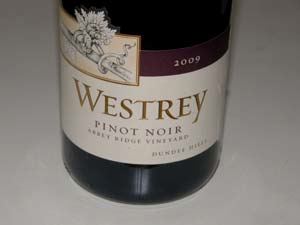 2009 Westrey Abbey Ridge Vineyard Dundee Hills Willamette Valley Pinot Noir 13.5% alc., 219 cases, $33. Aged in 22% new French oak barrels. · Light reddish-purple color in the glass. Aromas of dark red and black berries with spice, floral and forest floor notes. Moderately intense mid palate presence showing power without weight with many subtle flavor nuances. Beautifully balanced with perfectly ripe and well-spiced berries returning to haunt the extraordinarily long finish.
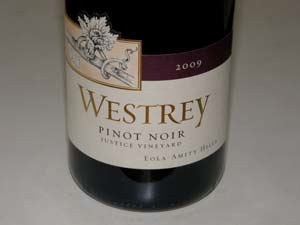 2009 Westrey Justice Vineyard Eola-Amity Hills Willamette Valley Pinot Noir 13.5% alc., 321 cases, $26. From a vineyard adjacent Bethel Heights Vineyard. Dijon 667 and 777 clones. 27% whole cluster. Aged in about 30% new French oak barrels. · Moderately light reddish-purple color in the glass. Enchanting perfume of fresh dark raspberry glaze with a lovely rose petal garnish. Vivid, discreetly concentrated core of an array of spicy berry fruits supported by ripe, well-integrated tannins, finishing with a long and graceful finish. More body and spice than Victoria’s Secret runway.
2009 Westrey Oracle Vineyard Dundee Hills Willamette Valley Pinot Noir 13.7% alc., pH 3.58, TA 0.55, 844 cases, $23. Westrey’s first estate vineyard is located just north of Abbey Ridge Vineyard. 76% primarily Dijon 777 with small percentages of five other Dijon clones and 24% 32- year-old Pommard clone. Indigenous yeast fermentation. Aged in 20% new French oak barrels. Unfined and unfiltered. · Moderately light reddish-purple color in the glass. Very fresh aromas of black raspberries and boysenberries with a hint of Asian 5-spice. Delicious dark red cherry and dark berry flavors with a forest tone. Gripping tannins dwarf the fruit initially, but the flavors gain intensity and interest over time in the glass. Like the other two Westrey vineyard-designates, this wine displays a lavish and persistent finish. Not extremely approachable now and will benefit from further bottle aging. Very good (+).
WillaKenzie Estate
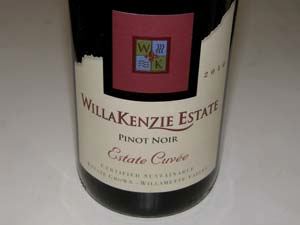 2010 WillaKenzie Estate Estate Cuvée Estate Grown Willamette Valley Pinot Noir 13.5% alc., pH 3.65,TA 0.50, $28, screw cap. Aged 10 months in 20% new French oak barrels. · Moderately dark reddish-purple color in the glass. Fruity nose offering an array of ripe, dark cherry, plum and berry aromas. Pushes the ripeness envelope with medium weight flavors of dark raspberries, black plum sauce, and black currants with a hint of vanilla cola and oak. Softly textured with firm, ripe tannins, lacking a bit in acid-driven vibrancy. Quite approachable now. Good (+).
2009 WillaKenzie Estate Aliette Estate Grown Willamette Valley Pinot Noir 14.2% alc., $39. This vineyard was the first planted at WillaKenzie and is named after the mother of owner Bernard Lacroute to reflect the feminine nature of the wine. 100% Pommard clone. · Moderately light reddish-purple color in the glass. Subdued aromas of red cherries and berries with a floral riff. Medium weight flavors of red cherries and raspberries underlain with toasted oak, ending with a cherry-laden finish. Mild, fine-grain tannins, bright acidity, and substantial tannins that tend to overwhelm the delicate fruit. Good (+).
Kick Up Your Heels at the 2012 Oregon International Pinot Noir Celebration
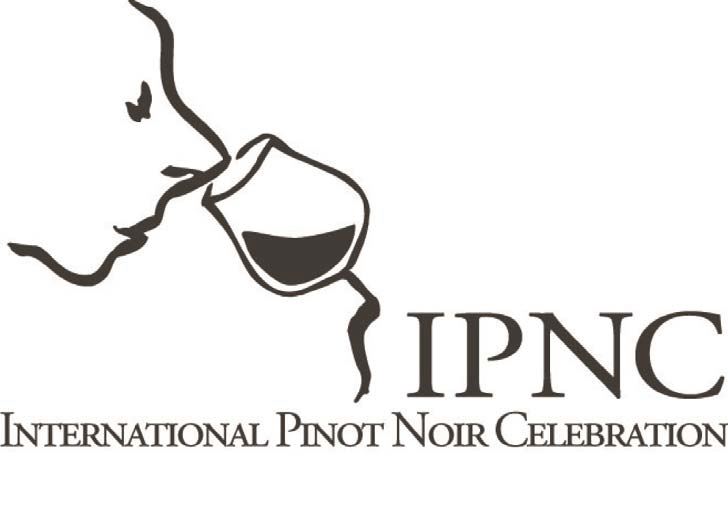 Now that you have drooled over the many Pinot Noir delights from Oregon, how about visiting Oregon wine country and attending the granddaddy of all Pinot Noir Festivals, the International Pinot Noir Celebration (IPNC)? It has often been said that Americans know how to make great Pinot Noir, but sadly they are still trying to master the art of living. Maybe the French could teach us a thing or two in this regard, but from the reveling that goes on each year in July at the IPNC, I think we have a solid grasp of joie de vivre. Noted wine writer, Gerald Asher, who attended the 10th IPNC in 1996, and wrote about his experience in Gourmet (December 1996), said, “Despite all the comparisons between Bordeaux and Burgundy (and thus between Cabernet Sauvignon and Pinot Noir) that have preoccupied us for years, no one seems to have made much of the fact that producers of Cabernet worldwide take themselves seriously, while producers of Pinot Noir like to kick up their heels and frolic.” The first IPNC was launched on a modest scale twenty-six years ago, and today it continues to attract pinotphiles from around the world to the tiny campus of Linfield College in McMinnville, Oregon, where they enjoy three days of world-class Pinot Noir, northwest cuisine, and international camaraderie. Winemakers, wine writers, wine fans, and food aficionados gather to celebrate an elusive and wonderful gift of nature: Pinot Noir. The IPNC is unique for several reasons. First, it is held on a small, bucolic college campus and nearly all events including meals are held outdoors. Second, it is attended by more Burgundian vignerons than any other Pinot Noir festival in North America. Third, there is a good mix of winemakers, winery owners, winegrowers, wine distributors, wine retailers, restaurateurs, wine writers and consumers. Fourth, the event is educational and themed so the 700 guests who attend each year come away with a message and some useful information (no tests or grades, however). Fourth, the event draws highly lauded chefs from the Pacific Northwest and features the finest artisan foods of the region. The meals are simply spectacular. Lastly, great Pinot Noir flows like water. The 2012 IPNC Keynote speaker will be actor, funny-man and wine lover Kyle MacLachlin, an owner with Eric Dunham of Pursued by Bear Winery in Walla Walla, Washington. MacLachlin has appeared in a number of well-known television shows and movies including ‘Dune,’ ‘Sex & the City,’ and ‘Desparate Housewives.’ A resident of Eastern Washington where he grew up, MacLachlin will be sure to make fun of Pinot Noir drinkers in his Opening Ceremony keynote talk.
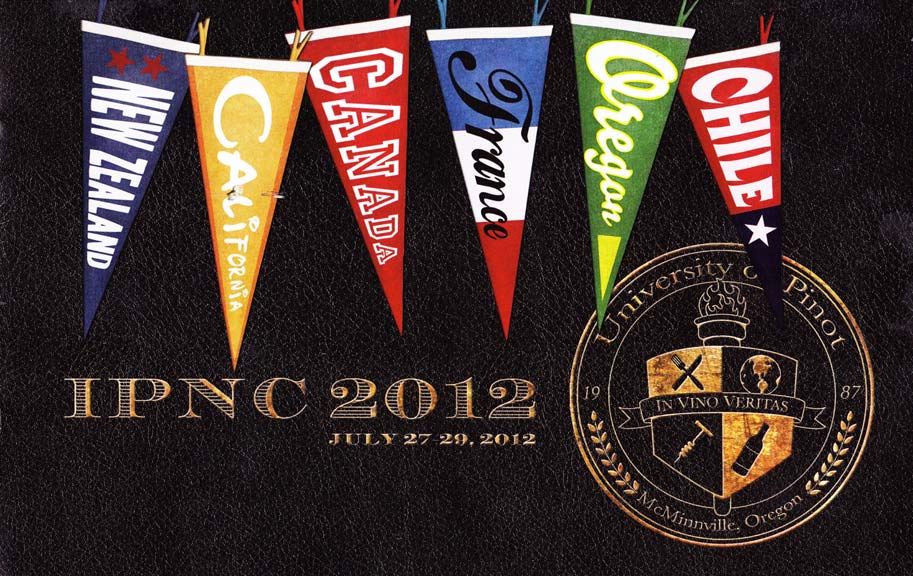 This year’s theme is “University of Pinot.” The Grand Seminar will feature Allen Meadows, the unsurpassed expert on Burgundy, who will lead Study Abroad in Burgundy, a tour through the vineyards of Chambolle- Musigny, Echezeaux, Gevrey-Chambertain, Nuits-Staint-Georges, and Vougeot. Attendees will taste examples and hear from winemakers Bertrand Ambroise of Maison Ambroise, Grègory Gougues of Domaine Henri Gouges, Jacques Lardière of Maison Luis Jadot, and Philippe & Vincent Lècheneut of Domaine Lècheneaut. Each winemaker is bringing gems from their cellars to demonstrate the charm of each village. Multiple small-format afternoon on-campus seminars will cover one of the many aspects of Pinot Noir in depth. Sit in air conditioned classrooms (you will appreciate this if the temperature is over 90ºF which it often is in the Willamette Valley in July) and taste special wines offered by the speakers. Best of all, there is no homework or tests! The seminars include the following.
Climatology 201: Coolest of the Cool Climate Pinots How close to the climatic edge do you have to be to make the best Pinot Noir? Led by Jason Lett of The Eyrie Vineyards and featuring Rob Stuart of R. Stuart & Co., Cyril Audoin of Domaine Charles Audoin, Andy Peay of Peay Vineyard, and Blair Walter of Felton Road. Georgraphy 301: New Zealand Pinot Noir Tour A guided tour of some of New Zealand’s finest Pinots led by Anna Metzinger of Archery Summit and featuring Rudy Bauer from Quartz Reef, Steve Smith from Craggy Range, Nick Lane from Cloudy Bay, and Helen Masters from Ata Rangi. Geology 401: The Real Dirt on California Pinot Learn about the complex relationship between soil and Pinot Noir wines led by Robert Brittan of Brittan Vineyards, featuring Fin du Fresne of Chamisal Vineyards, Carroll Kemp of Red Car Wines, and Greg LaFollette of La Follette Wines. Globalization101: The Revenge of the Terroirists Author Mike Veseth explains how the homogenization of style affects all wine but that the stakes are highest for real terroir wines like Pinot Noir. Pinot 101: Sensory Evaluation of Pinot Noir A guided tasting with noted Pinot Noir wine critic, Josh Raynolds, of the International Wine Cellar hosted by Bill Stoller. Social Studies 301: Pinot to The Third Power - The Cube Project Winemakers Andrew Brooks of Bouchaine, Thomas Houseman of Anne Amie Vineyards, and Leslie Renaud of Lincourt swapped grapes in a unique experiment to determine if wine is more a reflection of the vineyard terroir or the hand of the winemaker. Students will taste and decide for themselves. As in college, there is competition for classes so you should enroll early to ensure your first choice. If you have Pinot overload, there are two other afternoon extracurricular seminar options: Tea Seminar (Portland’s Steven Smith of Smith Tea takes you through a guided tasting), and Coffee from Seed to Cup (Stumptown Coffee’s Jonathan Sielaff guides students through the life of a bean from seed to cup, including growing, processing, exporting, roasting, preparing and enjoying.) On one day attendees will attend on-campus seminars and on the other day, enjoy a unique vineyard tour and winery and lunch. The winery you will be visiting is kept a secret until you are on the bus traveling to the winery. At the winery, you will be enrolled in Life Sciences 425: Conception Production and the Mysteries of Pinot Noir. A short video, shot during harvest, will trace your host winemaker’s steps as they guide the grapes from vine to barrel, and of course, you will taste the end product. After the tasting, enjoy an array of wines paired with a multi-course lunch crafted by one of the esteemed guest chefs. Two exclusive Post-Grad Opportunities are offered this year at IPNC for the first time. You must enroll in these separately as they are not included in the IPNC Full Weekend ticket.
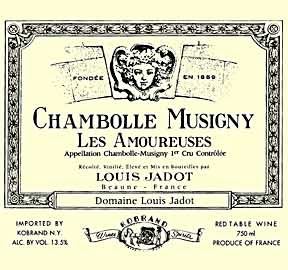 Icons of the new World: The Pinots of Adelsheim and Hanzell David Adelsheim, Dave Paige and Michael McNeill will lead you through a tasting of treasures from the libraries of these historic wineries.
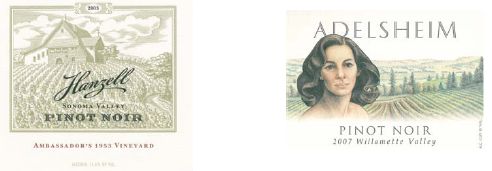 Pinot Noir is the most food-friendly wine, and no event celebrating Pinot Noir would be complete without food. At IPNC, you are treated to the finest northwest cuisine from dawn until the late evening throughout the weekend. From a farm-fresh buffet breakfast Friday and Saturday, to the al fresco Grand Dinner on Friday and the Northwest Salmon Bake on Saturday, and ending with the Sunday Sparkling Brunch, over 60 chefs including many of the northwest’s finest, create sumptuous dishes to pair with Pinot Noir. Some noted chefs at IPNC this year are Dustin Clark (Wildwood), Gabriel Rucker (Le Pigeon and Little Bird), Jason Stoller Smith (Timberline Lodge), Timothy Hodges (La Rambla), Chris Israel (Grüner), and Jason Franey (Canlis). (Note: tickets for the Northwest Salmon Bake can be purchased separately, but that event is already sold out.) A number of Pre-IPNC dinners are also offered and tickets for these events may be purchased separately whether you are attending the full IPNC weekend or not. These dinners are not organized by IPNC, so contact the wineries directly for tickets. Visit www.ipnc.org for a listing of these incredible dinners. These dinners are so popular they sell out quickly, so do not procrastinate. I will be attending the ¡Salud! Benefit Dinner with special guest of honor Jacques Lardière of Maison Louis Jadot. All proceeds benefit ¡Salud!, a charity that I support that provides healthcare to Oregon vineyard workers. The Featured Chef is James Beard Award Finalist Cathy Whims of Nostrana Restuarant in Portland. This dinner will be held on the grounds of Linfield College. Contact Lindsay Coon for tickets at 503-681-1850 or lindsay.coon@tuality.org.
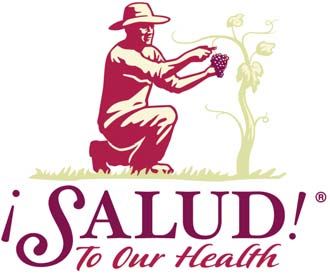 Speaking of procrastination, tickets for IPNC sell out each year. Lodging in the Willamette Valley is limited and the best accommodations fill up quickly. Some housing is available in the campus dorms where I usually stay for convenience. They are a bit spartan, but that is part of the weekend charm. Shuttles are provided to the event from many nearby hotels. The IPNC is less than 3 months away, July 27-29.
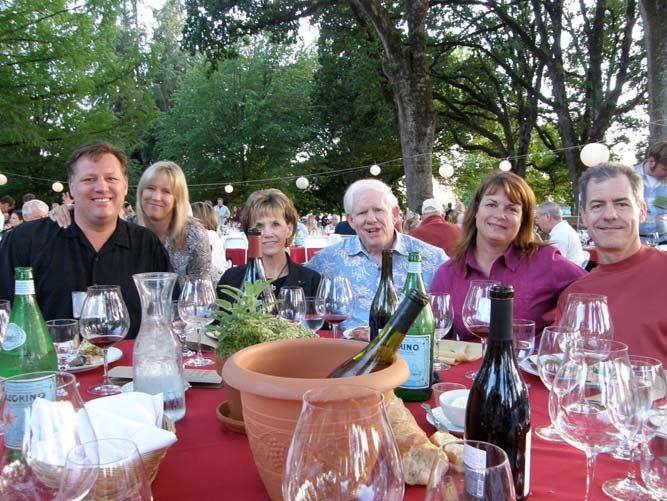
Oregon Wine Press: News You Can Use on the Oregon Wine IndustryCurrent popular wine publications offer only an occasional glimpse of Oregon wine. Oregon Wine Press delivers a monthly magazine featuring the “who, what, when, where of wine in Oregon.” I have been a long time subscriber (a steal at $20 per year) and frequent the highly informative Oregon Wine Press website (www.oregonwinepress.com) to get the latest Pinot Noir news instantly.
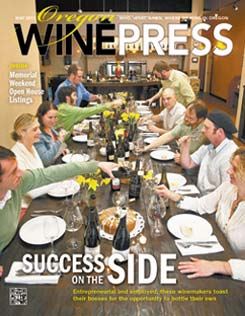 I recently talked with the Oregon Wine Press Managing Editor, Hilary Berg, whose spouse, Chris Berg, is a winegrower and winemaker in the Willamette Valley (Roots Wines & Vineyard). Being intimately involved in the Oregon wine industry, and with a background in journalism, she has brought considerable life to this magazine since her arrival. Q: What is your upbringing and educational background? A: I was born and raised in Wichita, Kansas. I have four siblings, including my identical twin sister. I graduated from the University of Kansas with a bachelor of science in journalism. Q: What was your first introduction to wine? A: I was introduced to wine through my husband, Chris, who is a winemaker and winegrower. He introduced me to Oregon wine while I was still in college at the University of Kansas, which is where I met him. When he moved to Oregon to enter the wine industry, I followed. We married in 2003. I have been in Oregon since 2000. We own a small 7-acre vineyard and wine label called Roots and will be celebrating our tenth vintage this coming fall. Q: What is the history of the Oregon Wine Press and when did you join the staff as Editor? A: Portland-area natives Richard Hopkins and Elaine Cohen started what was then named the Oregon Wine Calender in 1984. They nurtured the publication for 22 years, promoting and growing with the Oregon wine industry. In April 2006, Oregon Wine Press was acquired by the News-Register Publishing Co., a family owned, fourth generation publishing company in McMinnville. I am the one who approached the News- Register owner, Jeb Bladine, and suggested he buy the Oregon Wine Press. At the time, the magazine had just ceased publishing, and in turn, he hired me. At the time, I was working about an hour from my home in Yamhill and wanted to work closer to home. He hired me, and the rest is history. Q: What do you find inspiring about your job? A: I really enjoy creating something from start-to-finish. I also love creative collaboration with the many talented writers and photographers in Oregon, most importantly, with Karl Klooster, Associate Editor of Oregon Wine Press. Q: How is Oregon Wine Press distributed? I know it is available by subscription, but what are the other avenues of distribution? A: We distribute Oregon Wine Press to more than 600 businesses, free of charge. Most of our circulation is in Oregon, but we do have out-of-state distributors that lover our publication and regularly remind us when a shipment gets lost or damaged. We would love to grow our distribution across the United States to include select wine shops in every state. We are working on this right now. Q: Oregon Wine Press does not have a significant emphasis on wine reviews. Why is that? A: Oregon Wine Press is intended to celebrate and explore the wine industry, not grade wines. We are more interested in the stories within the industry, which national publications rarely touch on. The only reviews we publish are in a department we call “Value Picks.” We only print positive reviews for wines under a certain price. We focus on select varieties each month, giving the wineries another outlet for reviews. Q: Talk about what is offered on your website. A: Our website offers articles from present and past issues, as well as a brand new calender system that allows users to connect with social media sites like Facebook and Twitter. We are so busy with the print edition, the website has been a second priority, at least for me - I am too darn busy! We hope to upgrade the look and functionality over the coming year, so stay tuned - or, should I say, stay logged on. Q: How do you account for the popularity of Oregon Pinot Noir? A: Pinot Noir is the most food friendly red out there. I believe the popularity of Oregon Pinot Noir is in large part due to high quality and the (mostly) genuine people who make it. Q: What changes do you foresee in the next 10 years in the Oregon wine industry? A: Not really sure. I know the quality and notoriety of Oregon wine will continue to rise. I hope to see more Tempranillo planted in Southern Oregon. I believe that variety is promising as the region’s flagship wine. I think Tempranillo could catapult the Southern Oregon AVA to a higher status.
Oregon Pinot BriefsAntica Terra Champagne Luncheon Antica Terra will host an exclusive lunch and tasting of inspirational Champagne on Saturday, May 19, at The Woodsman Tavern in Portland, OR. Chef Jason Barikowski will prepare five courses to accompany the five grower Champagnes that inspired the creation of Antica Terra’s new wines. A barrel tasting of base wine from the 2010 and 2011 vintages will precede the lunch. Featured Champagnes will include Cedric Bouchard Inforescence La Parcelle Côte de Bechalin, Jerome Prevost La Closerie, Jacques Seloss Cuvée Initial, Vilmart 2003 Coeur de Cuvée and Egly Ouriet Blanc de Noirs Les Crayeres V.V.. Cost is $175 per person.
 Antica Terra Onsite Tastings The onsite tasting experience will be taken to a new level starting this June. Curated by Antica Terra Director and Master Sommelier Nate Ready, visitors will not only be able to taste Antica Terra’s current releases, but also a rotating selection of wines from around the world that have inspired and sustained the Antica Terra creative process, ranging from grower Champagnes and Grand Cru Burgundies to esoteric bottlings from rare, indigenous grapes that feature innovative winemaking techniques. Tastings will be offered three times a day by appointment only from Tuesday through Sunday. The introductory flight is $70 per person and includes 1.5 oz pours of the following eight wines served with a selection of provisions thoughtfully sourced and crafted by six notable Portland chefs: Raphael Bereche M.V. “Reflet d’Antan” Champagne, 2008 Grange des Peres Blanc Aniane, 2010 Clos Cibonne Tibournen Rosé “Cuvée des Vignettes” Côtes de Provence, 2010 Antica Terra Rosé “Erratica”, 2010 Antica Terra Willamette Valley Pinot Noir, 2010 Antica Terra “Botanica” Pinot Noir, 2009 Anne Gros Clos Vougeot, and 2007 Moric Blaufrankisch “Lutzmannsburg Alte Reben” Burgenland. All wines will be served from an Enomatic wine system. Wines are expected to change every four to six weeks based on availability. All wines will also be available for purchase in limited quantities. Antica Terra Winery is located at 979 SW Alder Street in Dundee. Reservations can be made by called 503-244-1748 or by email at info@anticaterra.com. Willamette Valley Vineyards Contest May is Oregon Wine Month and marks the beginning of the 8th annual “Why I Love Oregon Pinot Noir” contest sponsored by Willamette Valley Vineyards. Wine enthusiasts are urged to tell their story about when or where they fell in love with Oregon Pinot Noir. The most creative entry will win an all-expenses-paid trip for two to Oregon Wine Country and Willamette Valley Vineyards. Submissions can include a short essay, photos, or even a video. Visit www.wvv.com/contest for the official rules and to enter. The contest runs May 1 through June 30, 2012. Second and third place winners will receive a Copper River Salmon dinner for six delivered to their door including recipes, wine and more. Memorial Day Weekend in Oregon Wine Country Many small Oregon wineries are only open to the public twice a year on Memorial Day weekend and Thanksgiving weekend. The 22nd annual Memorial Weekend in the Wine Country, May 26-28, 2012, kicks off the Oregon wine tasting season in the Willamette Valley with more than 150 wineries and tasting rooms opening their doors for special events and tastings. Visit the Willamette Valley Wineries website (www.willamettewines.com) to plot your wine tasting routes. Use the Mobile Wine Tour to navigate to your next destination, offering directions to the wineries right on your smart phone. To receive a mailer that includes a list of activities at each winery and a touring map, email info@willamettewines.com and include your mailing address since the mailer is available by postal service only. You can also visit the Oregon Wine Board website at www.oregonwine.org for Oregon wine country brochures and a listing of Oregon wine events. Domaine Drouhin Rosé Oregon is becoming well known for its superb rosés (think Antica Terra, Domaine Serene, Luminous Hills and Soter) and Domaine Drouhin offers one of the best. The DDO Edition Rosé is not made every year, but the 2011 Edition has just been released and will sell out quickly. Pinot Noir is picked carefully from the winery’s 35 estate blocks, hand-sorted, de-stemmed and moved to stainless steel fermentation tanks. After 12 hours, when the ideal color is reached, some of the juice from each tank is bled off, a true saignée. Fermentation starts naturally with wild yeast and the wine is kept at cooler temperatures, allowing the aromatics and fruit flavors to develop. After 5 months, 575 cases of the 2011 Edition Rosé were bottled in March. Available for $20 online at www.domainedrouhin.com.
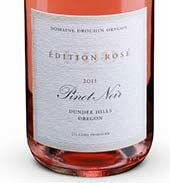 Superior Cellar Awards Oregon Wine Press and the Oregon Wine Board offer a listing of restaurants in Oregon and nationally that feature a diverse selection of Oregon wines on their wine list. Visit www.oregonwinepress.com/article?articleTitle=superior+cellar+awards--1307400145--792--top-stories for an article and a list of Superior Wine Cellar restaurants.
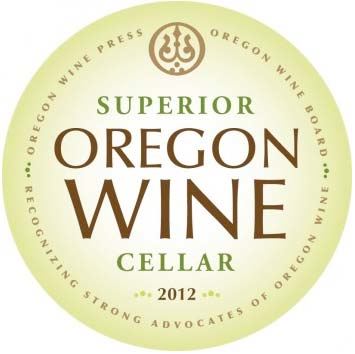 Oregon Sources for Oregon Pinot Noir There are nearly 500 Oregon wine stores including wineries. The following are recommended online retailers who stock a large collection of Oregon Pinot Noir: Avalon Wine (www.avalonwine.com), the most comprehensive source, Bend Wine Cellar (www.bendwinecellar.com), Northwest Wines To You (www.northwestwinestoyou.com), Oregon Pinot Noir Club (www.oregonpinotnoir.com), Oregon Wine Merchants (www.orwines.com), Storyteller Wine Co. (www.storytellerwine.com), Vinopolis Wine Shop (www.vinopoliswineshop.com), and Wine Merchants West (www.winemerchantswest.com). The Oregon Wine Board also provides a wine locator service, the Oregon Wine Finder, at www.oregonwine.org. Don’t forget the wineries themselves as they often carry wines only available through the winery, and offer significant discounts for multiple bottle purchases and wine club members. Dealing directly with wineries can open the door to wines produced in small quantities and allocated. Buying direct and establishing a personal relationship with winery personnel can enhance your wine drinking experience and allow you to gain entrance to special winery events. The advantage of retailers is that they offer a broad range of choices and may offer discounts on multiple bottle purchases and shipping. Oregon has an open and non discriminatory direct shipping law and Pinot Noir can be freely shipped within Oregon and to any state that permits wine shipments. If you live on the West Coast, you can acquire Oregon Pinot Noir with no difficulty. Free online searches for Oregon Pinot Noir include: www.wine-searcher.com, www.winezap.com, www.vinquire.com, www.wineaccess.com, and www.vinopedia.com. Documentary Features Oregon Wine Industry Founders The new documentary, “Oregon Wine: Grapes of Place,” has been released. A co-production of Oregon Public Broadcasting and the Oregon Historical Society, the video premiers on OPB TV May 8, 2012, at 8:00 PM. Producer and writer Nadine Jelsing interviewed many veterans of the Oregon wine industry including David Adelsheim, Dick Erath, and Dick Ponzi, and included taped interviews with David Lett, the founder of The Eyrie Vineyards, who died in 2008. For more information, visit www.oregonlive.com, or www.opb.org. Oregon Olive Mill at Red Ridge Farms This is the first olive oil processing plant in Yamhill County and the largest commercial mill in the Northwest. The facility features a state-of-the art Italian olive mill which is used to process their multiple olive varieties including Arebequina, Koroneiki and Tuscan. The Oregon Olive Mill supplements their locally grown fruit with olives sourced from family farmers in Northern California. The oils were tested by an independent lab and certified as meeting IOOC standards for Extra Virgin Olive Oil. Owner Paul Durant is striving to produce olive oils that are rich in flavor, with initial fruit notes followed by strong pungency and bitterness that reflects the nature of the fruit. 2011 was the the largest milling run to date and the largest harvest of fruit from estate grown olives as well. Oregon Olive Mill’s fresh virgin olive oils from the 2011 vintage are currently available at Red Ridge Farms and direct to consumer shipping through www.redridgefarms.com.
Notice: I have been deluged with California Pinot Noir to sample and review. I apologize to those who have submitted wines, for I have not been able to publish the reviews in a timely fashion. I have been traveling and will be doing quite a bit of wine country travel over the next two months as well, but I will attempt to get caught up. Currently, I review every Pinot Noir and Chardonnay that is submitted, and I refuse to fail to give each wine less than a well-deserved complete evaluation. ........Prince.
Pinot Gris: Pinot Noir’s Mutant Offspring Needs Love Too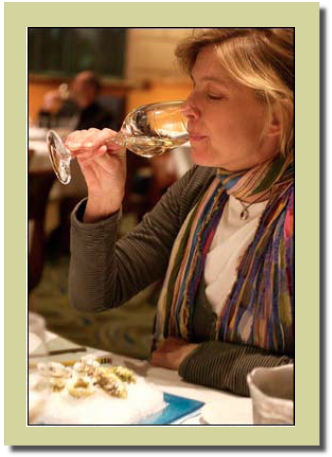 Traditionally, wines from France like Muscadet and Chablis are chosen to accompany oysters on the half shell. Few wines go with oysters because they are a vibrant combination of minerals, sweetness and the sea. To identify wines that restaurants can reliably offer customers ordering oysters on the half shell, the Pacific Coast Oyster Wine Competition was organized eighteen years ago by its founder, Jon Rowley of Jon Rowley & Associates of Seattle, Washington who are consultants to the seafood industry. At the recently concluded Eighteenth Annual Pacific Coast Oyster Wine Competition, 25 top West Coast food and wine experts bestowed the prestigious “Oyster Wine Award” on ten West Coast Wineries. Judges rated the “bliss factor” after smelling and chewing a Taylor Shellfish Farms Kumamoto oyster than smelling and tasting each of the competing wines. Six of the ten winning wines were Pinot Gris, two were Sauvignon Blanc, one was a dry Chenin Blanc and one a Pinot Blanc. It is noteworthy that among the 101 entries, the judges preferred Pinot Gris over all other white varietals as the perfect accompaniment to fresh oysters on the half shell.
Two of the Pinot Gris wines receiving an “Oyster Wine Award” were from Oregon:
Van Duzer Vineyards Estate pinot Gris has won two previous “Oyster Wine Awards.” The other Pinot Gris wines winning an “Oyster Award” were from Washington and Russian River Valley, California. Winemaker Terry Brandborg of Brandborg Vineyard & Winery has had a long and endearing relationship with oysters. He relates the following story. “As a young man, I lived across the hill from West Marin and Tomales Bay in California where oysters were farmed. It became a regular ritual to trek out on weekends and consume a few dozen barbequed oysters with pitchers of Anchor Steam beer. I now view barbeque oysters as a “gateway” experience to the more sublime and ethereal sensations that delight the palate and soul when slurping down fresh shucked gifts from the ocean, washed down with our clean, bone dry, brightly acidic, minerally Pinot Gris.” |